Qixiang Electron Science and Technology AT5888UVIII LAND MOBILE RADIO User Manual 15 5888UV III UserMan
Qixiang Electron Science& Technology Co., Ltd LAND MOBILE RADIO 15 5888UV III UserMan
15_5888UV III UserMan.pdf

TRI-BAND FM TRANSCEIVER
5888UV III
USER'S MANUAL

Nice Housing, Stoutness & Stability, Advanced and Reliable
functions, Perfect & Valuable. Approval. TRI Band mobile
radio especially designs for drivers and it pursues company
philosophy of innovation and practicality.
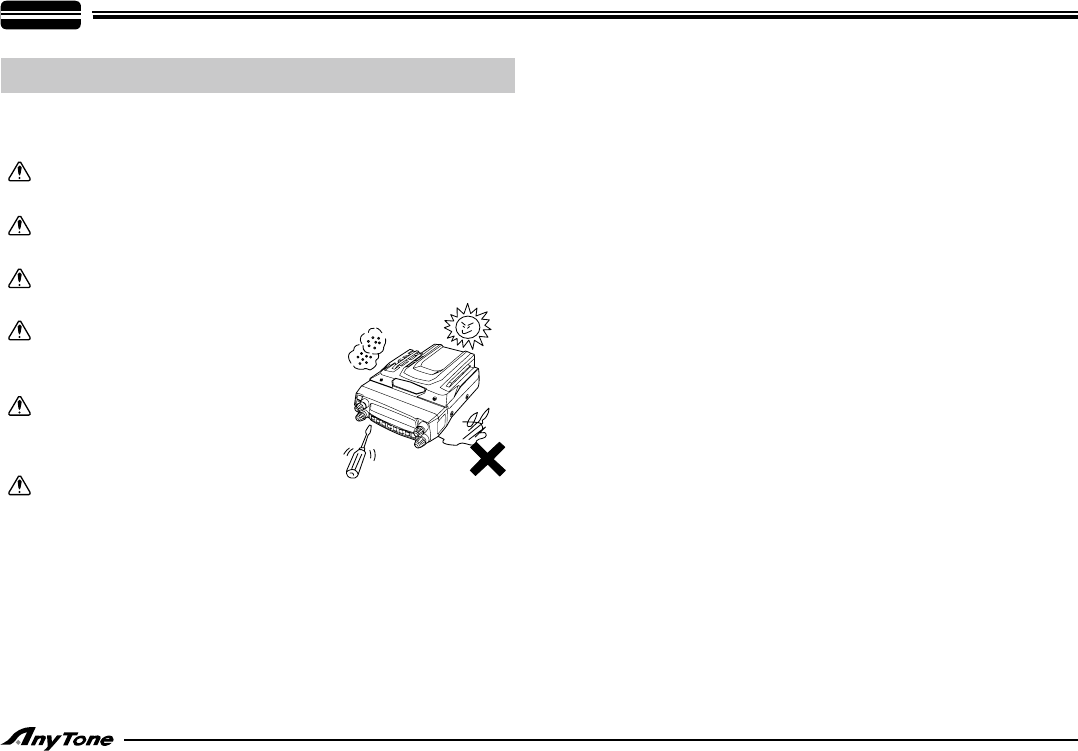
NOTE: This equipment has been tested and found to comply with
the limits for a Class B digital device, pursuant to part 15 of the FCC
Rules. These limits are designed to provide reasonable protection
against harmful interference in a residential installation. This equipment
generates, uses, and can radiate radio frequency energy and, if not
installed and used in accordance with the instruction manual, may
cause harmful interference to radio communications. However, there is
no guarantee that interference will not occur in a particular installation.
If this equipment does cause harmful interference o radio or television
reception, which can be determined by turning the equipment off and on,
the user encouraged to try to correct the interference by one or more of
the following measure:
• Reorient or relocate the receiving antenna.
• Increase the separation between the equipment and receiver.
• Connect the equipment into an outlet on a circuit different from that to
which the receiver is connected.
• Consult the dealer or an experienced radio/TV technician for help.
This device complies with Part 15 of the FCC Rules. Operation is subject
to the two conditions:
(1) This device may not cause harmful interference, and
(2) This device must accept any interference received, including
interference that may cause undesired operation.
Changes or modications to this unit not expressly approved by the party
responsible for compliance could void the user's authority to operate the
equipment.
Precautions
Please observe the following precautions to prevent fire,
personal injury, or transceiver damage:
Do not attempt to congure your transceiver while driving, it
is dangerous.
This transceiver is designed for a 13.8V DC power supply.
Don't use a 24V battery to power on the transceiver.
Do not place the transceiver in excessively dusty, humid or
wet areas, nor unstable surfaces.
Please keep it away from
interferential devices (such as TV,
generator etc.)
Do not expose the transceiver to
long periods of direct sunlight nor
place it close to heating appliances.
If an abnormal odor or smoke is
detected coming from the transceiver, turn OFF the power
immediately. Contact an Anytone service station or your
dealer.

CONTENTS
New and Innovative Features ...................................................1
Frequency Range ...................................................................1
Supplied Accessories ...............................................................2
Supplied Accessories ..............................................................2
Initial Installation .......................................................................3
Mobile installation ...................................................................3
DC Power Cable Connection ..................................................4
Antenna Connection ...............................................................6
Accessories Connections ........................................................7
Getting Acquainted ...................................................................8
microphone .............................................................................8
Basic Operations .......................................................................9
Switching The Power On/Off ...................................................9
Adjusting The Volume ............................................................9
Adjusting Frequency ...............................................................9
Adjusting Channel ...................................................................9
Selecting the frequency band ...............................................10
Receiving ..............................................................................10
Squelch Off/Squelch Off Momentary.....................................10
Shortcut Operations ................................................................11
Squelch level Setup ..............................................................11
Home Channel ......................................................................11
Editing Home Channel ..........................................................11
Hyper Memory channel ......................................................... 11
Dual Watch............................................................................11
Emergency Alarm ..................................................................11
Channel/Frequency Scan ..................................................... 11
Channel Scan Skip ...............................................................12
Channel Edit .........................................................................12
Scan range Limit ..................................................................12
Channel Copy .......................................................................12
Channel Delete .....................................................................12
General Setting ........................................................................13
APO (Automatic Power off) ...................................................13
Automatic offset ....................................................................13
VFO Band lockout .................................................................14
Beep Function .......................................................................14
CPU Clock frequency Change ..............................................14
2TONE Encode select ..........................................................14
5TONE Encode select ..........................................................15
Add Optional signaling ..........................................................15
CTCSS/DCS encode Setup .................................................15
Sub Band Display Setup .......................................................16
DTMF Encode Pre-Loading time ..........................................16
DTMF Encode setup .............................................................16
Squelch Mode Setup .............................................................17
Compander ...........................................................................17
Scrambler Setup ...................................................................17
Tone Burst (Pilot Frequency) ................................................18
Keypad Mode Setup .............................................................18
Keypad Lockout ....................................................................19
Squelch Level setup ..............................................................20
Frequency Reverse ...............................................................20
Editing Channel Name ..........................................................20
Channel Function Auto storeage Setup ................................20
Microphone PA,PB, PC,PD key setup ..................................21
RF Squelch level setup .........................................................21
Scan Dwell Time Setup .........................................................21

Priority channel scan .............................................................21
Offset frequency Setup .........................................................22
Display mode Setup ..............................................................22
Busy Channel Lockout ..........................................................22
Radio's DTMF SELF ID ENQUIRY .......................................23
5TONE SELF ID ENQUIR ....................................................23
VFO Frequency Linkage .......................................................23
LCD backlight ........................................................................23
Keypad backlight brightness .................................................24
Calling Record ......................................................................24
AM Function ..........................................................................24
Automatic AM function ..........................................................24
VHF External speaker port ....................................................25
BEEP Volume control ..........................................................25
Talk Around........................................................................... 25
Microphone speaker............................................................. 25
Password Function ...............................................................26
Microphone Operation ............................................................27
Function operation through PA-PD keys ...............................27
Memory Banks .........................................................................29
Assigning A Channel To A Memory Bank ..............................29
Choosing Active Banik ..........................................................29
Bank Linking .........................................................................29
Maintenance .............................................................................30
Default Value For Factory Resume ......................................30
Trouble Shooting ...................................................................30
Specications ..........................................................................31
Attached Chart .........................................................................32
51 groups CTCSS Tone Frequency(Hz) ...............................32
1024 groups DCS Code ........................................................32
CONTENTS

1
1
Frequency Range
RX: 136~174MHz
220~260MHz
400~512MHz
TX: 144~148MHz
222~225MHz
420~450MHz
New and Innovative Features
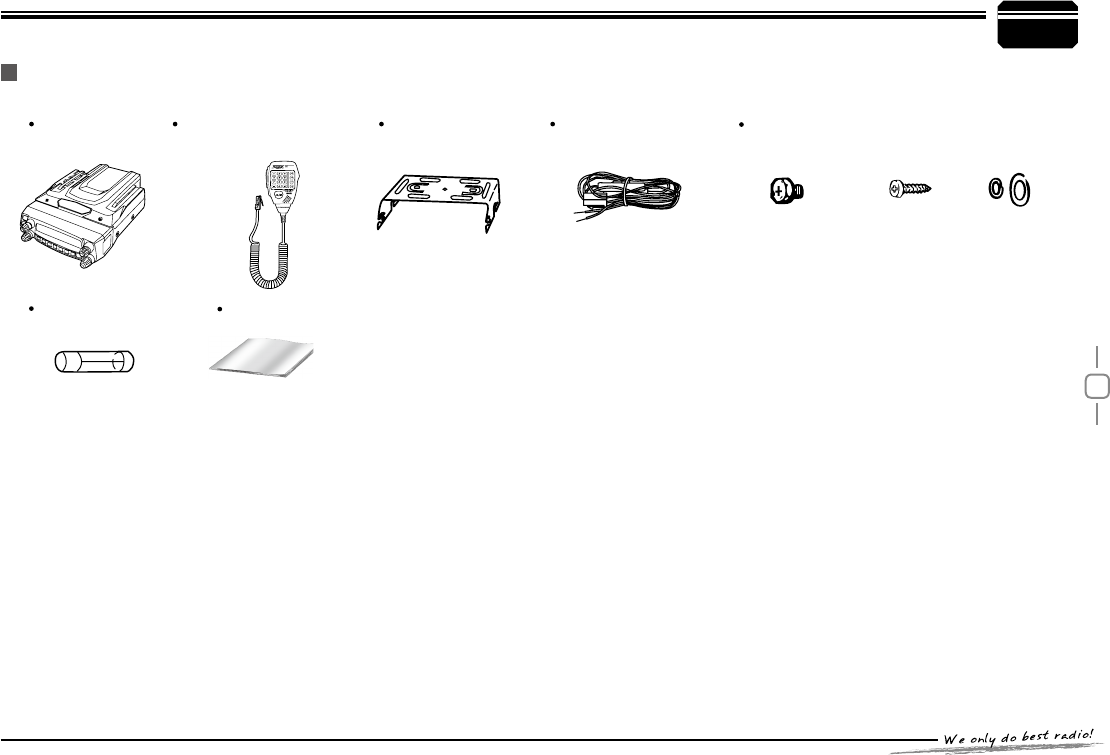
2
2
Supplied Accessories
SUPPLIED ACCESSORIES
After carefully unpacking the transceiver, identify the items listed in the table below. We suggest you keep the box and packaging.
Transceiver
Spare Fuses
(QF-01)
User Manual
Mobile Mounting
Bracket (QMB-01)
DC Power Cable with
Fuse Holder(QPL-01)
Microphone (QHM-05)
(with DTMF keyboard) S-Washer
(QSS-01D)
Hardware Kit for Bracket
Black screws
(M4X8mm)
4PS(QSS-01A)
Tapping screws
(M5X8mm)
4PS(QSS-01B)
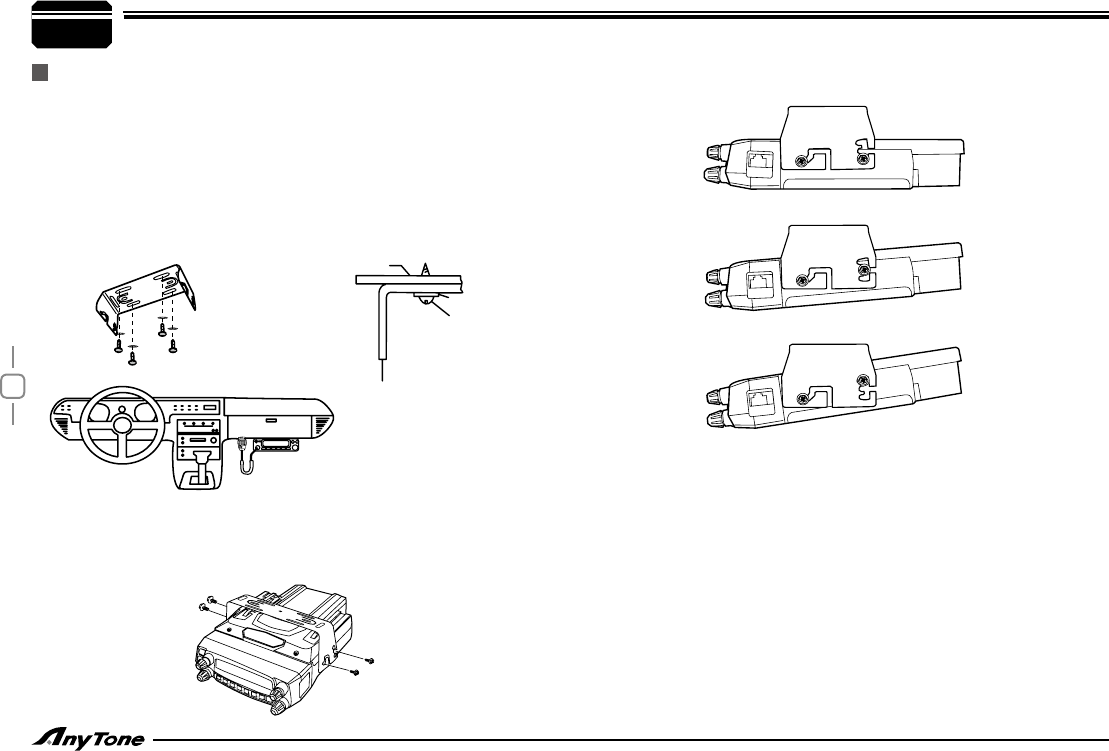
3
3
MOBILE INSTALLATION
To install the transceiver, select a safe, convenient location inside your
vehicle that minimizes danger to your passengers and yourself while the
vehicle is in motion. Consider installing the unit at an appropriate position
so that knees or legs will not strike it during sudden braking of your
vehicle. Try to pick a well ventilated location that is shielded from direct
sunlight.
Install the mounting bracket in the vehicle using the supplied self-
1.
tapping screws (4pcs) and at washers (4pcs).
Position the transceiver, then insert and tighten the supplied hexagon
2.
SEMS screws.
Car body
Mounting bracket
Washer (M5)
Tapping screw
(M5X20mm)
Double check that all screws are tightened to prevent
vehiclevibration from loosening the bracket or transceiver.
Initial Installation
Determine the appropriate angle of the transceiver, using the 3
screw hole positions on the side of the mounting bracket.
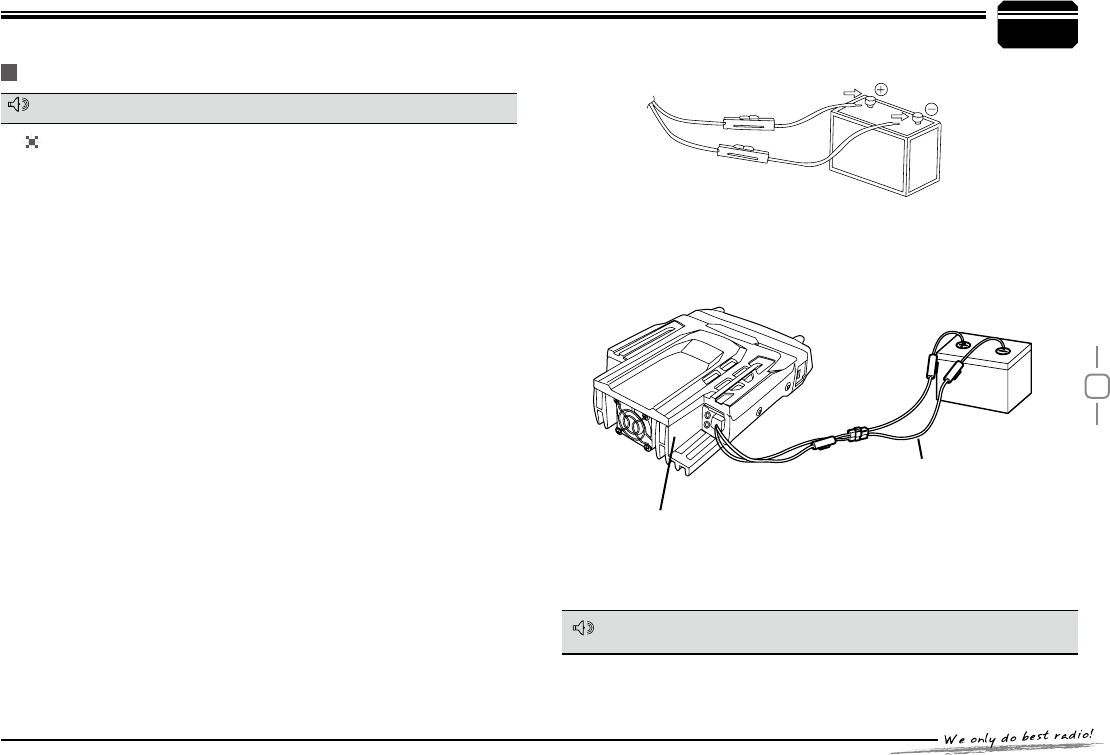
4
3
Initial Installation
DC POWER CABLE CONNECTION
Locate the power input connector as close to the transceiver as possible.
MOBILE OPERATION
The vehicle battery must have a nominal rating of 12V. Never connect
the transceiver to a 24V battery. Be sure to use a 12V vehicle battery
that has sufcient current capacity. If the current to the transceiver is
insufcient, the display may darken.
Route the DC power cable supplied with the transceiver directly
1.
to the vehicle's battery terminals using the shortest path from the
transceiver.
We recommend you do not use the cigarette lighter socket
as some cigarette lighter sockets introduce an unacceptable
voltage drop.
The entire length of the cable must be dressed so it is isolated
from heat, moisture, and the engine secondary (high voltage)
ignition system/ cables.
After installing cable, in order to avoid the risk of damp, please
2.
use heat-resistant tap to tie together with fuse box. Don't forget
to reinforce whole cable.
In order to avoid the risk of short circuit, please cut down
3.
connection with negative (-) of battery, then connect with radio.
Conrm the correct polarity of the connections, then attach the
4.
power cable to the battery terminals; red connects to the positive
(+) terminal and black connects to the negative (-) terminal.
Use the full length of the cable without cutting off excess even
if the cable is longer than required. In particular, never remove
the fuse holders from the cable.
Reconnect any wiring removed from the negative terminal.
5.
Connect the DC power cable to the transceiver's power
6.
supplyconnector.
Press the connectors rmly together until the locking tab clicks.
If the ignition-key on/off feature is desired (optional feature), use the
Red
Black
optional QCC-01(For Cigar-Plug connection) cable. Connect one of
the cables between the ACC terminal or a Cigar-Plug that operates
with the vehicle ignition or ACC switch on the vehicle and EXT
POWER jack on the rear side of the unit.
Ext. Power jack
DC power cable
In many cars, the cigar-lighter plug is always powered. If this is the case,
you cannot use it for the ignition key on/off function.
NOTE
NOTE
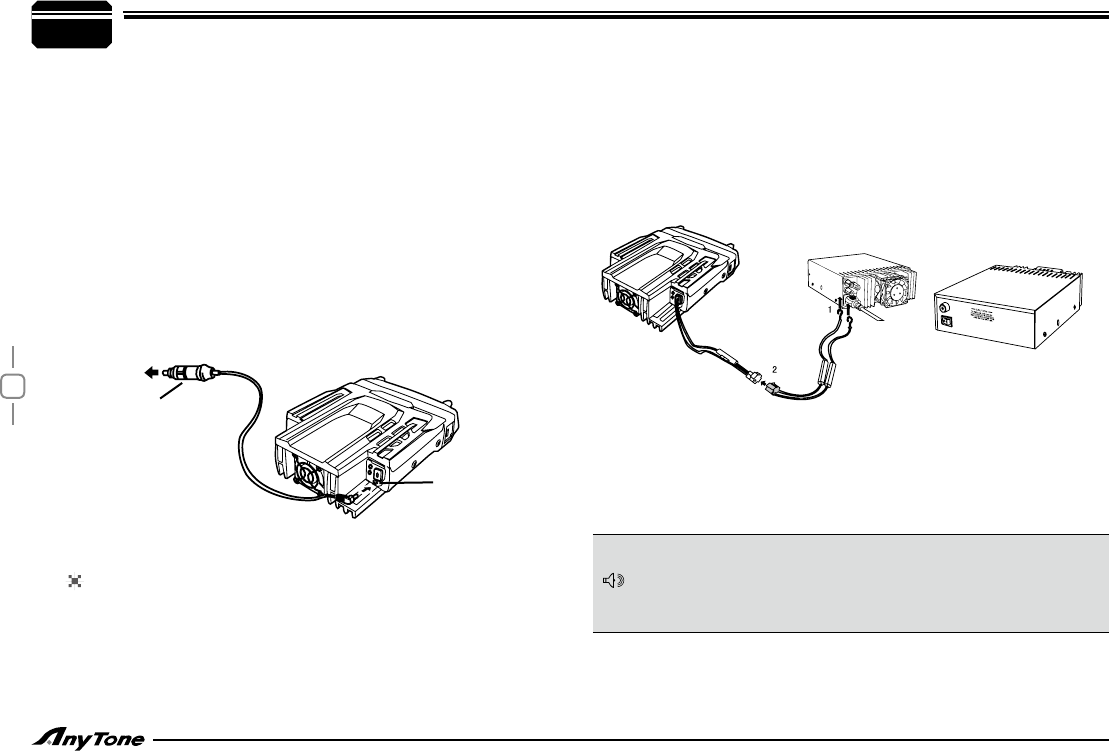
5
When the ignition key is turned to ACC or ON(Start) position
7.
with the radio turned off, the power switch illuminates. The
illumination will be turned off when the ignition key is turned
to the off position. To turn on the unit, press the power switch
manually while it is illuminated. (While ignition key is at ACC or
ON position).
3Initial Installation
When the ignition key is turned to ACC or ON position with the
8.
radio's power switch on, the unit turns on automatically and the
power switch will be lit. Turn the ignition key to OFF position or
manually turn the power switch off to shut down the radio.
Using extra cable, power consumption: 5MAH.
9.
Without this function, user can turn on/off radio by Power knob.
10.
Do not directly connect the transceiver to an AC outlet.
Use the supplied DC power cable to connect the transceiver
to a regulated power supply.
Do not substitute a cable with smaller gauge wires.
FIXED STATION OPERATION
In order to use this transceiver for xed station operation, you will
need a separate 13.8V DC power supply (not included), power
supply (QRP-01) as optional accessories. Please contact local
dealer to require.
The recommended current capacity of your power supply is 12A.
Before connecting the DC power to the transceiver, be sure to
switch the transceiver and the DC power supply OFF.
Do not plug the DC power supply into an AC outlet until you
make all connections.
DC power cable with fuse holder (QPL-01)
Regulated
power supply (QRP-01)
Connect the DC power cable to the regulated DC power supply
1.
and ensure that the polarities are correct. (Red: positive,
Black:negative).
Connect the transceiver's DC power connector to the
2.
connector on the DC power cable.
Press the connectors rmly together until the locking tab clicks.
NOTE
Ext. Power jack
Cigar-Plug connection
ACC terminal
Black
Red
Regulated power supply
(QRP-01)
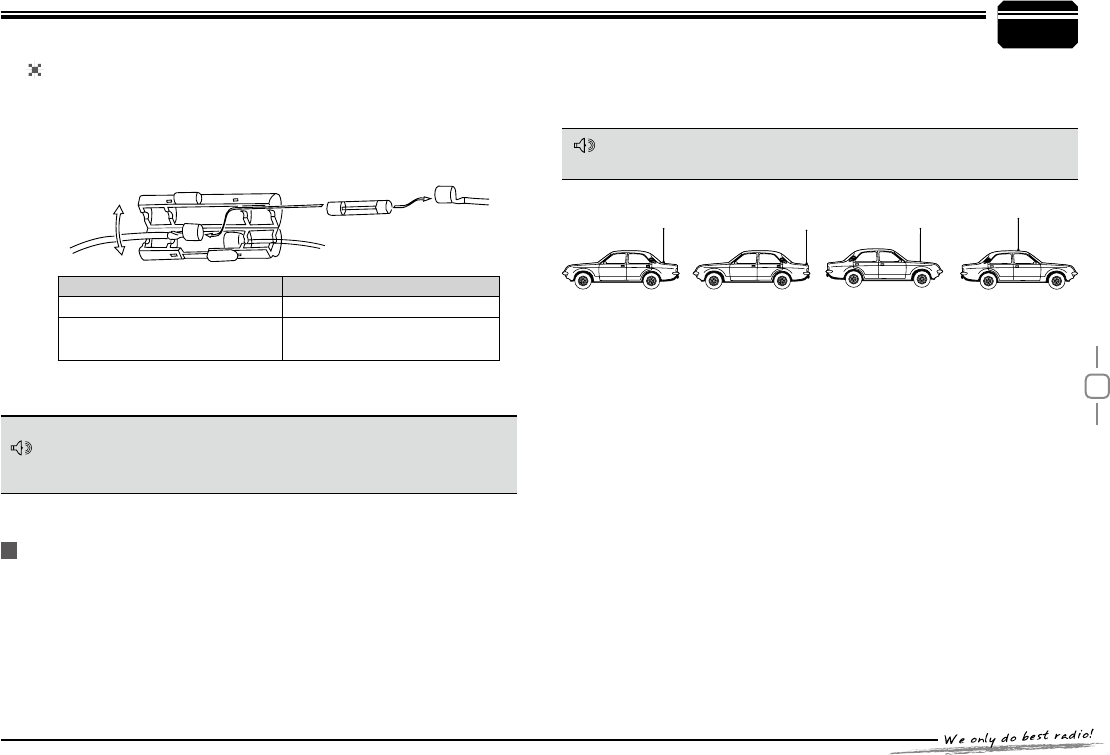
6
If the fuse blows, determine the cause, then correct the problem.
After the problem is resolved, replace the fuse. If newly installed
fuses continue to blow, disconnect the power cable and contact your
authorized dealer or an authorized servicecenter for assistance.
Only use fuses of the specified type and rating, otherwise the
transceiver could be damaged.
Before operating, install an efcient, well-tuned antenna. The success of
your installation will depend largely on the type of antenna and its correct
installation. The transceiver can give excellent results if the antenna
system and its installation are given careful attention.
Use a 50Ω impedance antenna and low-loss coaxial feed-line that
has a characteristic impedance of 50 Ω, to match the transceiver input
impedance. Coupling the antenna to the transceiver via feed-lines having
The possible locations of antenna on a car are shown as following:
3
Initial Installation
REPLACING FUSES
If you use the transceiver for a long period when the vehicle battery is
not fully charged, or when the engine is OFF, the battery may become
discharged, and will not have sufcient reserves to start the vehicle. Avoid
using the transceiver in these conditions.
All xed stations should be equipped with a lightning arrester to
reduce the risk of re, electric shock, and transceiver damage.
Fuse Location Fuse Current Rating
Transceiver 15A
Supplied Accessory DC
power cable 20A
ANTENNA CONNECTION
an impedance other than 50Ω reduces the efficiency of the antenna
system and can cause interference to nearby broadcast television
receivers, radio receivers, and other electronic equipment.
NOTE
NOTE
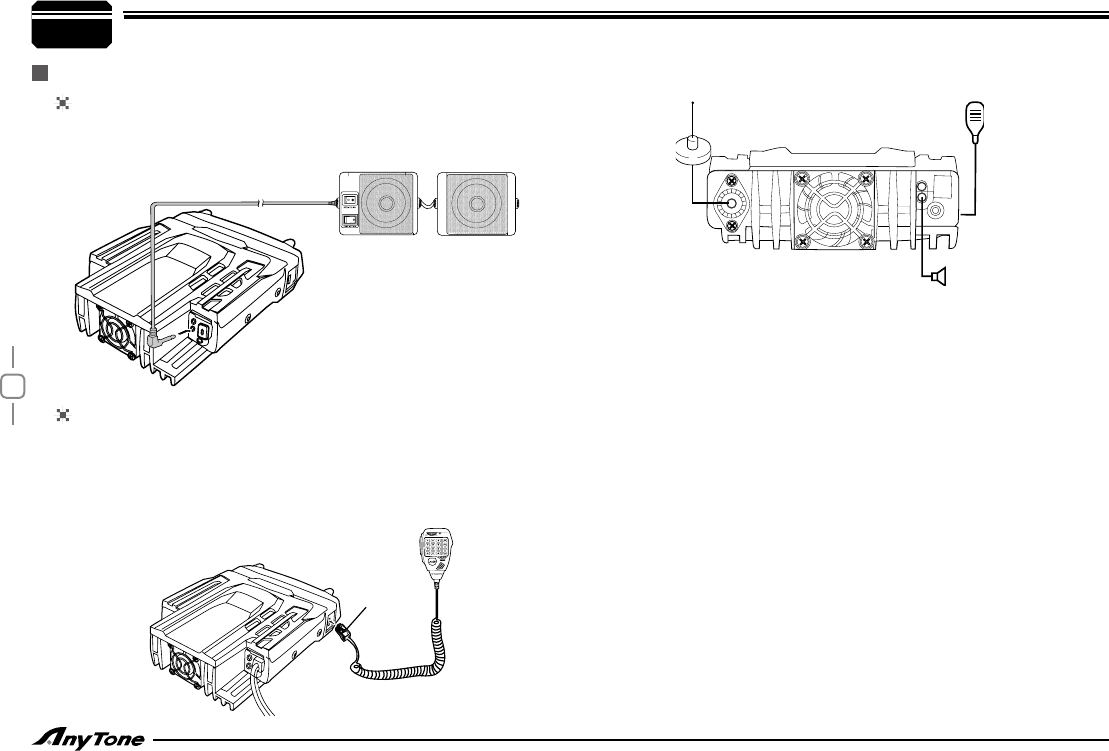
7
3
If you plan to use an external speaker, choose a speaker with an
impedance of 8Ω. The external speaker jack accepts a 3.5mm (1/8")
mono (2-conductor) plug.
For voice communications, connect a microphone equipped with an
8-pin modular plug into the modular socket on the front of the main
unit. Press rmly on the plug until the locking tab clicks. Attach the
supplied microphone hanger in an appropriate location using the
screws included in the screw set.
Initial Installation
EXTERNAL SPEAKER
MICROPHONE
ACCESSORIES CONNECTIONS
External speaker[SP-02]
Microphone[QHM-04]
Antenna[QCA-02]
Microphone
connector
SP-02
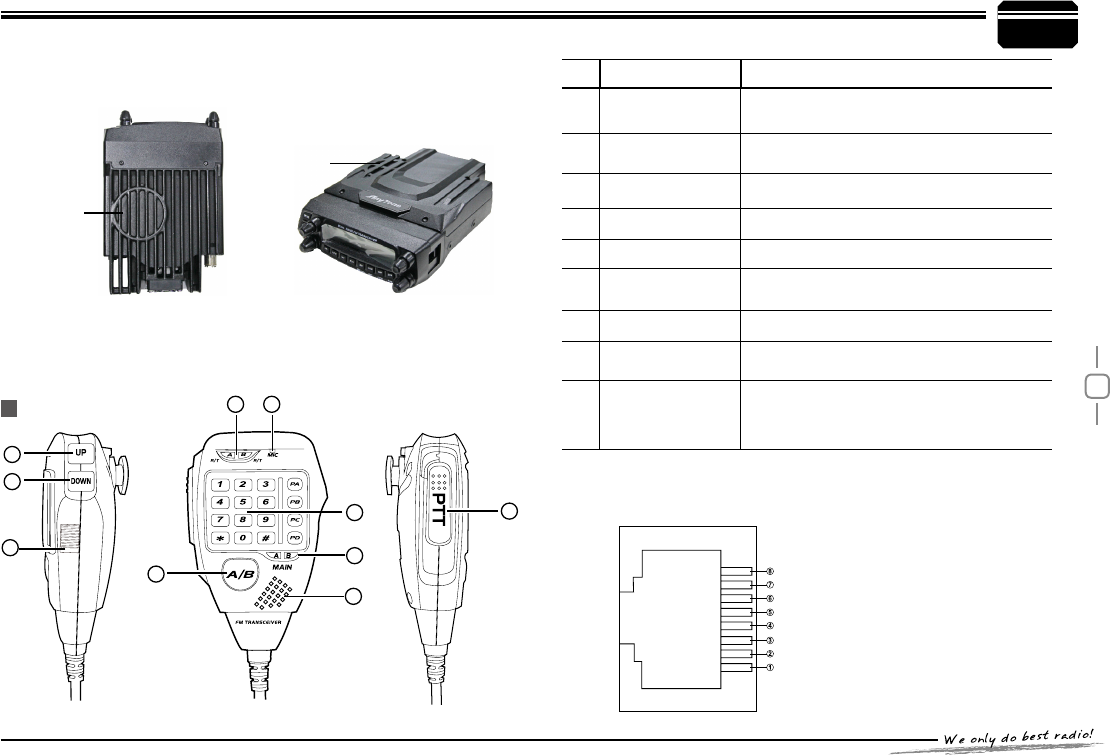
8
4
MIC Connector Diagram(in the front view of connector)
Getting Acquainted
Key Pad Serial Data
+5V
DOWN
UP
MIC GND
MIC
PTT
GND
MICROPHONE
1
2
10
3
5
6
9
7 8
4
NO. KEY FUNCTION
1 UP Increase frequency, channel number or
setting value.
2 DOWN Decrease frequency, channel number or
setting value.
4 Number Key Input VFO frequency or DTMF dial out etc.
5A/B band Choose left band or right band as Main band
6 Band indicator The indicator light on for Main band.
7 RX indicator Light green while receiving.
8 MIC Speak here during transmission.
9 Speaker When shut the speaker in the base, you can
hear the calling by this speaker.
10 Lock UP/down
When this key is in up position, It is unlock
UP/DOWN key, when this key is in down
poisition, UP/DOWN key will be locked.
Sub Speaker
Main Speaker
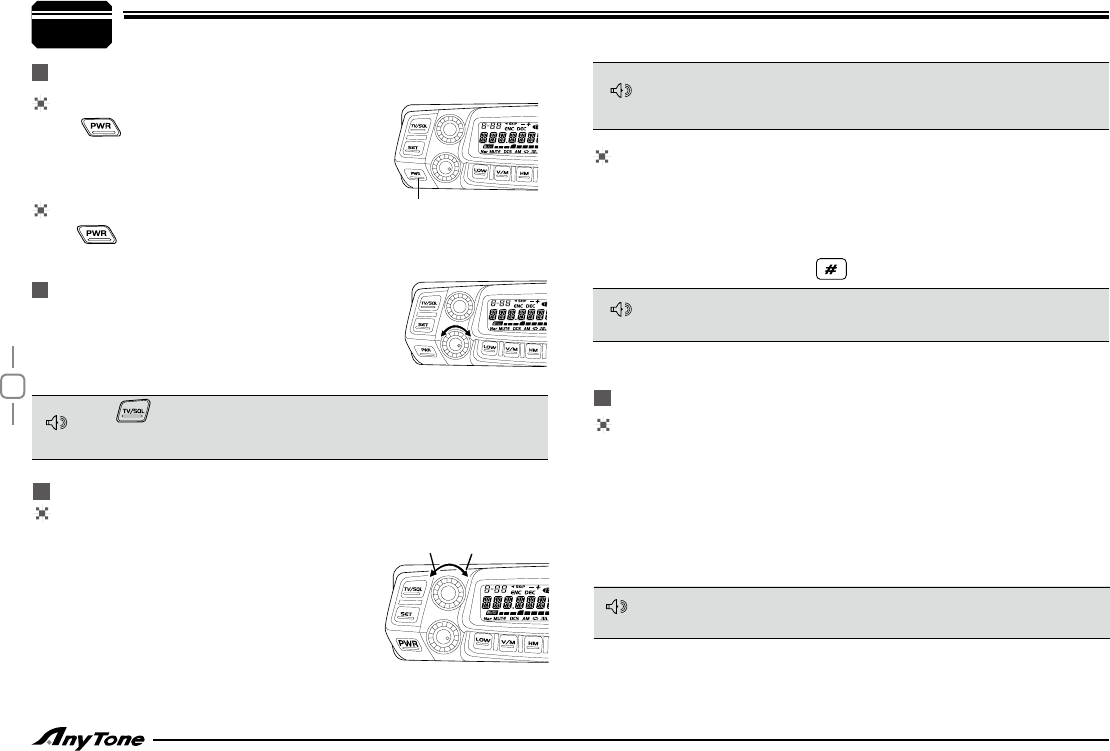
9
In frequency (VFO) mode, turn the selector
knob clockwise to increase frequency;
counterclock-wise to decrease frequency. Every
gear will increase or decrease frequency by
one step. To adjust the Main band frequency,
press corresponding selector knob, the left
side of decimal point will flash. In this status,
turn the selector knob will increase or decrease
frequency quickly by 1MHz step.
ADJUSTING FREQUENCY THROUGH SELECTOR KNOB
INPUT FREQUENCY THROUGH MICROPHONE NUMBER KEY
5Basic Operations
POWER ON
Press key to switch the transceiver ON,
the LCD displays "WELCOME ANYTONE", then
display current frequency or channel.
POWER OFF
Press key for over 0.5 Second to switch the
transceiver OFF.
Rotate the [VOLUME] knob of selected band
clockwise to increase the volume, counterclockwise
to decrease the volume.
SWITCHING THE POWER ON/OFF
ADJUSTING THE VOLUME
ADJUSTING FREQUENCY
Hold ,keep pressing it to Monitor the background noise after the
transceiver emits a DU beep, meanwhile adjust the [VOLUME] knob.
During communication, volume can be adjusted more accurate.
The microphone [ UP/DOWN ] key also able to adjust frequency.
Press [ UP/DOWN ] key will increase(decrease) the frequency by one
step size. Hold [ UP/DOWN ] key will adjust the frequency continuously.
When the Band lockout function is on, the input or adjusting of frequency
bandwill limit within the current VFO band.
Decrease frequency Increase frequency
In VFO mode, you can input the frequency by the microphone numeric
key. It is invalid to input frequency out of the frequency band.
For example:
to input 150.125Mhz, press 1, 5, 0, 1, 2, 5 continuously.
to input 152 MHz, press1, 5, 2, continuously.
ADJUSTING CHANNEL
ADJUSTING CHANNEL THROUGH SELECTOR KNOB
In channel mode, you can adjust the channel directly by the channel
knob. Turn clockwise to increase one channel; turn counterclockwise
to decrease one channel. To adjust the Main band channel, press
Power
Min
Volume
Max
Volume
NOTE
NOTE
NOTE
If there is any empty channel, the adjustment will ignore it and jump to
next channel.
correspondent selector knob, the channel number ashes in this situation,
the channel number will increase 10 channels by each gear of selector
knob. Press microphone [ UP/DOWN ] key also able to adjust the
channel.
NOTE
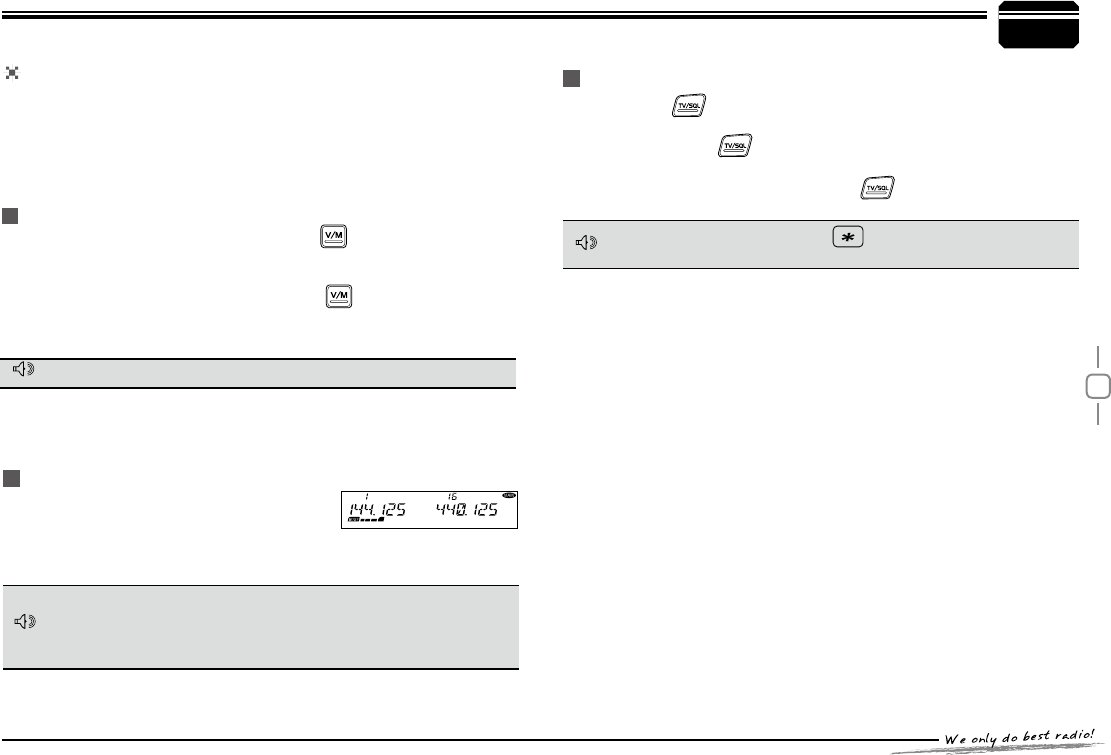
10
SELECTING THE FREQUENCY BAND
This transceiver can be set working on 2 UHF band or 2 VHF band.
INPUT CHANNEL THROUGH MICROPHONE NUMBER KEY
In channel mode, you can switch to desired channel by press 3 of the
microphone numeric keys (001-750). For example input 001 get channel
1; input 030 is channel 30; input 512 is channel 512. If the input channel
is no frequency, the transceiver will emit a warning beep and return to last
channel.
1. Choose for Left band: press the left side key to switch it to VFO
mode, press the left selector knob over 1 second then repeat above
operation will switch the left band.
2. Choose for right band: press the right side key to switch it to VFO
mode, press the right selector knob over 1 second then repeat above
operation will switch the right band.
5
Basic Operations
RECEIVING
If the transceiver has set at higher squelch level, it may fail to hear the
calling. If the “BUSY” and signal strength icon display in left band or
right band, but can not hear the calling, means the signal is with matching
carrier but dis-matching signaling.
In standby, both left band and right band are
able To receive. When they receive any signal,
the “BUSY” icon and signal strength icon will appear in the corresponding
area of the LCD. And you can hear the calling.
SQUELCH OFF/SQUELCH OFF MOMENTARY
Long press of key can be set up as Squelch Off or Squelch Off
Momentary to monitor the weak signal.
1. Squelch Off: Hold key until hear "Du" beep, the squelch is off,
repeat the above operation to resume squelch.
2. Squelch Off Momentary: Keep hold key to disable squelch,
release the key to resume squelch.
In standby, press the microphone to cancel squelch, press it again
to turn on the squelch.
NOTE
NOTE
NOTE
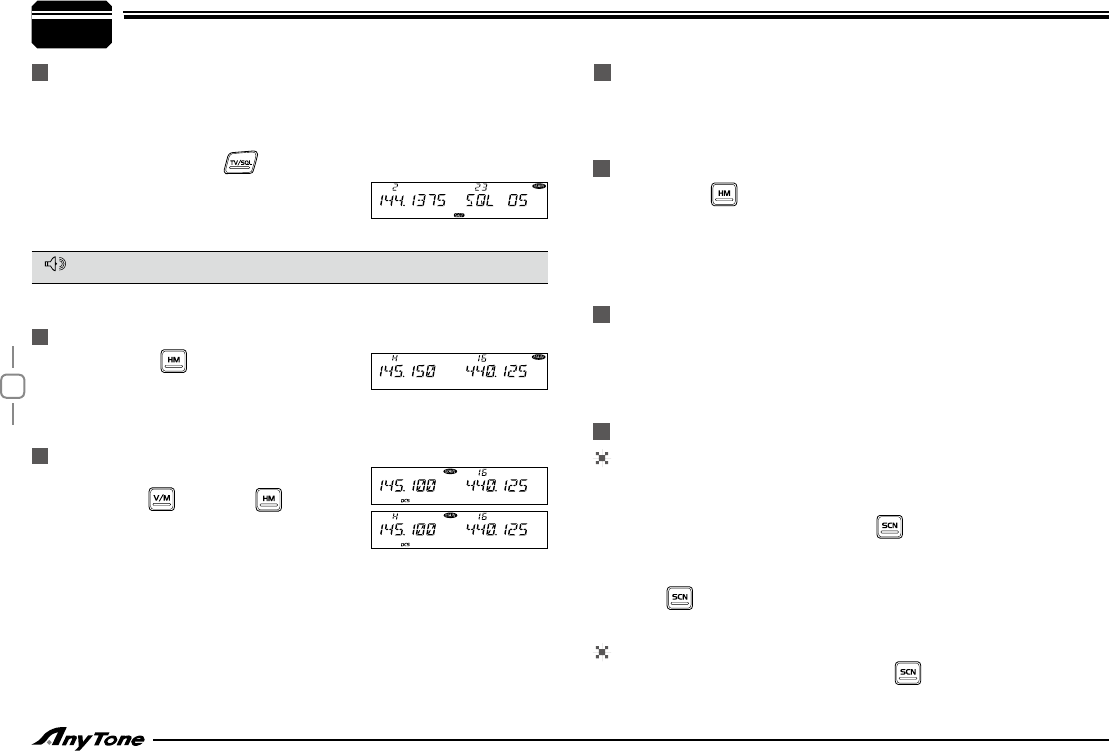
11
6Shortcut Operations
SQUELCH LEVEL SETUP
This function is used to setup the strength of receiving signal, when the
strength reach a certain level, the calling can be heard, otherwise, the
transceiver will keep mute.
In standby, press and hold key, meanwhile switch the selector knob
to adjust the squelch level of Main band.
1-20: Total 20 squelch levels available.
OFF: turn off squelch. The background noise always on.
The squelch level shall setup separately for right band and left band.
In standby, press key to switch to HOME
channel, and communicate on HOME channel.
repeat pressing it to return to last channel.
HOME CHANNEL
NOTE
HYPER MEMORY CHANNEL
In standby, press the left or right volume knob will switch the radio work
on hyper channel 1 or hyper channel 2.
In standby, hold key for over 0.5 second to enter Dual Watch mode.
The radio will scan the channel in every 5 seconds. When the radio
receives matching signal, it pause scanning until the signaling disappear.
Repeat above operation to exit Dual watch.
DUAL WATCH
FREQUENCY SCAN
CHANNEL/FREQUENCY SCAN
In VFO mode, this function is designed to monitor signal of every
communicative frequency point of "step size" you have set.
In VFO mode, press the Main Band
1. key to enter channel scan.
During the scanning adjust the Main band selector knob or press
2.
microphone [ UP/DOWN ] key will change the scan direction.
Press
3. key to exit scan.
CHANNEL SCAN
In channel mode, press the Main Band
1. key to enter channel scan.
EMERGENCY ALARM
To start emergency alarm, hold the right volume knob until the trans
-ceiver displays ALARM and emit alarm. Re-power on the transceiver to
exit alarm. This transceiver has 4 kind of alarm.
In VFO mode, after setting desired freq and
Channel, press then hold until radio
announces"DUDU", LCD displays H icon,
Home channel editing nished.
EDITING HOME CHANNEL
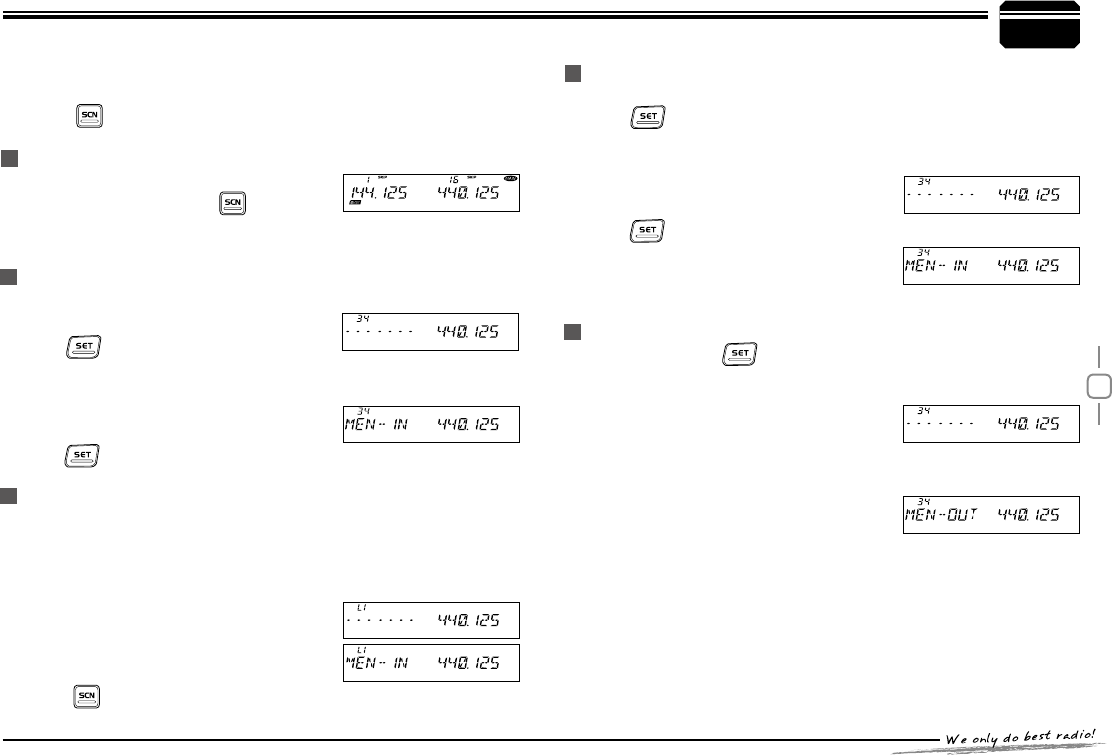
12
Shortcut Operations
In channel mode, switch selector knob to
choose the channel, then hold for over 0.5
second, the radio prompts "DU DU", and LCD displays "SKIP", and now
the current channel is Scan Skip.
In VFO mode, turn selector knob to select the desired frequency or
1.
input frequency by MIC's numeric keys.
Hold
2. key until the transceiver prompt
DU and the display of channel number ashes.
Turn selector knob to select the channel number to store. (If the
3.
storage has data, the LCD will display the
frequency, otherwise will display"----------")
Hold
4. key, the LCD display MEN- IN, the channel edit completed.
CHANNEL SCAN SKIP
CHANNEL EDIT
6
SCAN RANGE LIMIT
You can set the VFO scan frequency range by this function:
Choose upper limit and lower limit frequency, there are L1/U1- L5/
1.
U5, five couple of limit frequency for selection. L stands for lower
limit and U stands for the upper limit. the upper limit must over the
lower limit frequency. Please refer to the
Channel Edit to setup the limit frequency.
In VFO mode, set the VFO frequency in
2.
the range between upper and lower limit.
Press
3. key to start scan in lmited range.
During the scanning, adjust the Main band selector knob or press
2.
microphone [ UP/DOWN ] key will change the scan direction.
Press
3. key to exit scan.
In standby, hold
1. key until the transceiver prompt DU, and
channel number ashes.
Turn selector knob to choose channel number for delete. (If the
2.
storage has data, the LCD will display the
frequency, otherwise will display "----------")
Hold
3. Left band volume knob, until the transceiver emit DU DU
prompt and LCD displays MEN-OUT, the channel delete completed.
CHANNEL DELETE
storage has data, the LCD will display the
frequency, otherwise will display "----------")
Hold
4. key, the LCD displays MEN-IN, channel copy completed.
In channel mode, turn
1. the selector knob to choose the channel.
Hold
2. key until the transceiver prompt a Du and channel number
display ashes.
Turn selector knob to choose channel number for storage. ( If the
3.
CHANNEL COPY
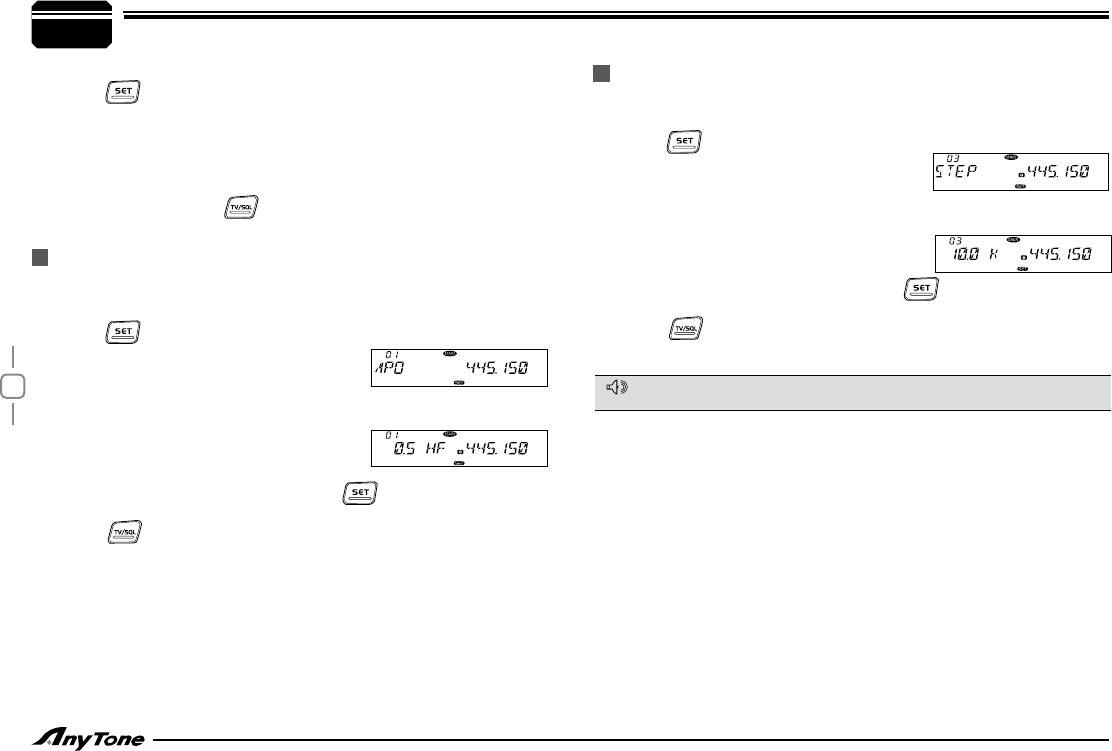
13
General Setting
Once APO is activated, the transceiver will be automatically switched off
when the pre-set timer running out.
Press
1. key to enter function menu.
Turn the Main band selector knob to
2.
choose No. 01 menu. The LCD displays
"APO".
Press the Main band selector knob to enter function setup.
3.
Switch the Main band selector knob to
4.
choose wanted value. Available values:
0.5-12Hours, OFF
Press the Main band selector knob or
5. key to store value and
back to function menu.
Press key or hold selector knob for over 0.5 second to store
setup and exit.
Only in frequency (VFO) mode, this function is valid. Turn selector knob to select
frequency or frequency scanning which is restricted by frequency step size.
Press
1. key to enter function menu.
Turn the Main band selector knob to choose
2.
No. 03 menu. the LCD displays "STEP".
Press the Main band selector knob to enter function setup.
3.
Switch the Main band selector knob to choose wanted value.
4.
Available Values:2.5K,5K,6.25K,
8.33K,10K,12.5K,15K,20K, 25K.
Press the Main band selector knob or
5. key to store value and
back to function menu.
Press key or hold selector knob for over 0.5 second to store
setup and exit.
APO (AUTOMATIC POWER OFF)
FREQUENCY CHANNEL STEP SETUP
7
Basic operation steps for Function menu
1. Press key to enter function menu.
2. Turn the Main band selector knob to choose wanted function.
3. Press the Main band selector knob to enter function setup.
4. Switch the Main band selector knob to choose wanted value.
5. Press the Main band selector knob to store value and back to
function menu. Press key or hold selector knob for over 0.5
second to store setup and exit.
This function is auto-hidden in channel mode
NOTE
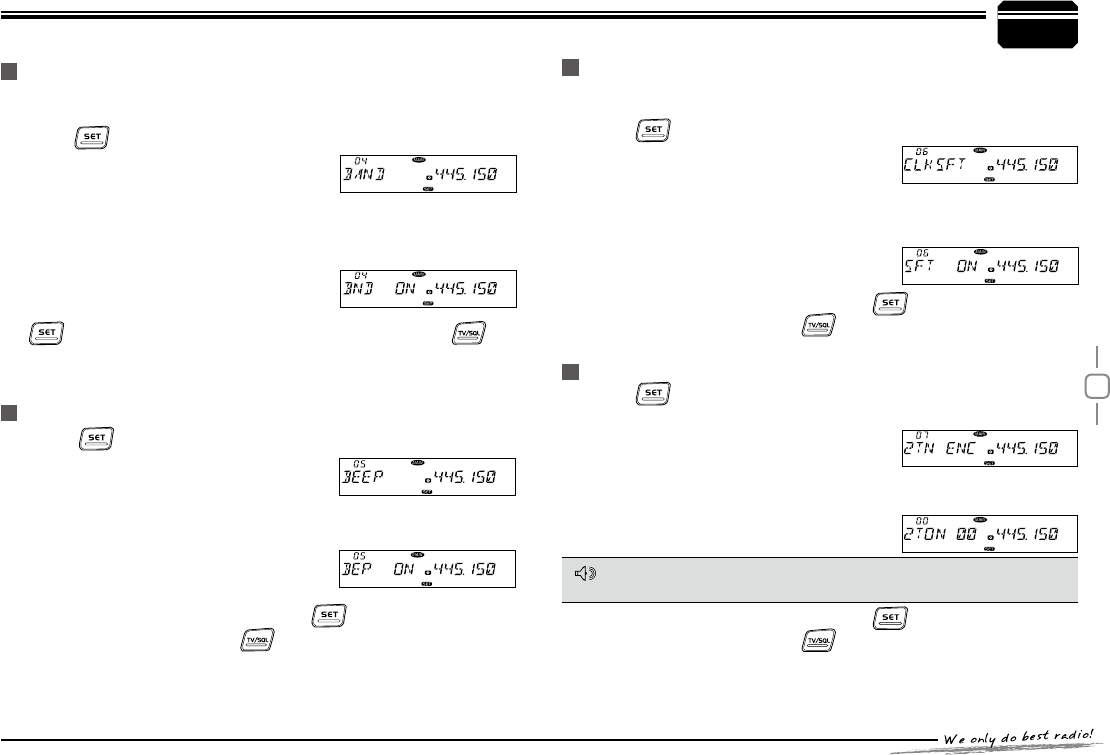
14
7
General Setting
In VFO mode, when this function is on, the scanning or input of frequency
will restricted within the current VFO frequency band.
Press
1. key to enter function menu.
Turn the Main band selector knob to choose
2.
No. 04 menu. the LCD displays "BAND".
Press the Main band selector knob to enter function setup.
3.
Switch the Main band selector knob to choose wanted value.
4.
ON: Turn on VFO band lockout function
OFF: Turn off VFO band lockout function
Press the Main band selector knob or
5.
key to store value and back to function menu. Press key
or hold selector knob for over 0.5 second to store setup and exit.
Press
1. key to enter function menu.
Turn the Main band selector knob to choose
2.
No. 05 menu. the LCD displays "BEEP".
Press the Main band selector knob to enter function setup.
3.
Switch the Main band selector knob to choose wanted value.
4.
ON: Turn on Beep function.
OFF: Turn off Beep function
Press the Main band selector knob or
5. key to store value and
back to function menu. Press key or hold selector knob for over
0.5 second to store setup and exit.
When any harmonic or image frequency in the CPU clock disturbs the
working frequency, turn on this function will cut the disturbing
Press
1. key to enter function menu.
Turn the Main band selector knob to
2.
choose No. 06 menu. the LCD displays
"CLK.SFT".
Press the Main band selector knob to enter function setup.
3.
Switch the Main band selector knob to choose wanted value.
4.
ON: Turn on CPU Clock frequency Change.
OFF: Turn off CPU Clock frequency Change.
Press the Main band selector knob or
5. key to store value and
back to function menu. Press key or hold selector knob for over
0.5 second to store setup and exit.
Press
1. key to enter function menu.
Turn the Main band selector knob to choose No. 07 menu. the LCD
2.
displays "2TN ENC".
Press the Main band selector knob to
3.
enter function setup.
Switch the Main band selector knob to
4. choose wanted value.
Available Values: 0-23, total 24 groups.
VFO BAND LOCKOUT
BEEP FUNCTION
CPU CLOCK FREQUENCY CHANGE
2TONE ENCODE SELECT
If the 2TONE encode are set up with name, the LCD will display
corresponding name.
Press the Main band selector knob or
5. key to store value and
back to function menu. Press key or hold selector knob for over
0.5 second to store setup and exit.
NOTE
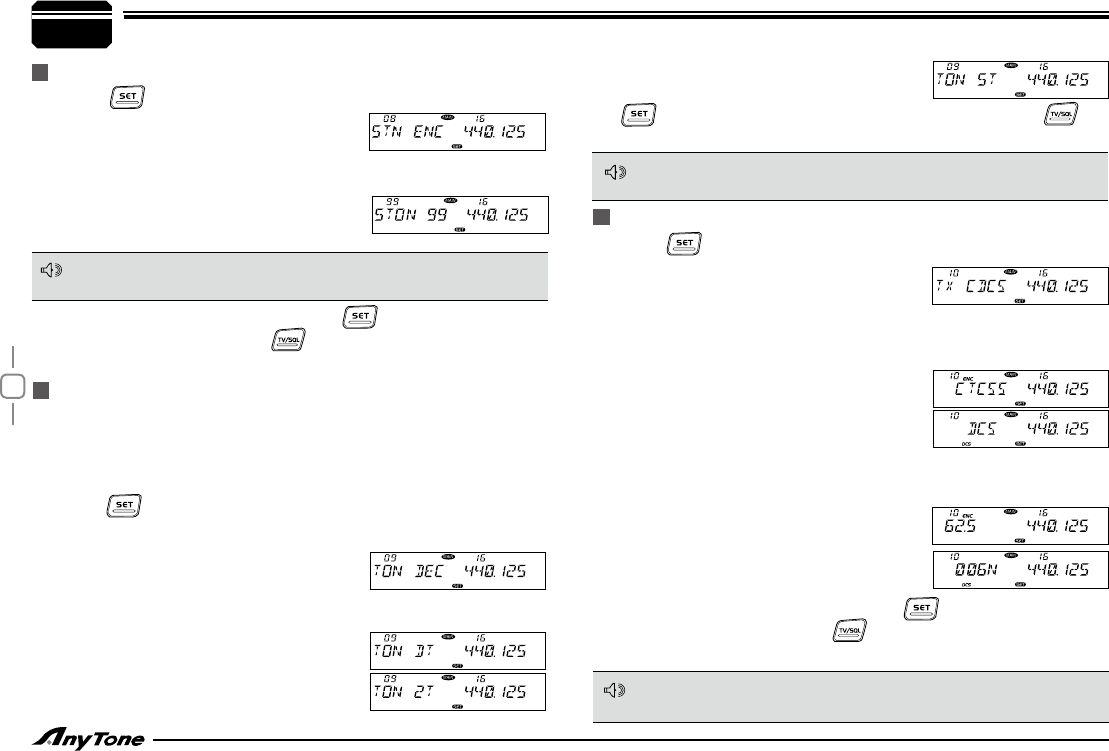
15
General Setting
Press
1. key to enter function menu.
Turn the Main band selector knob to
2.
choose No. 08 menu. the LCD displays
"5TN ENC".
Press the Main band selector knob to enter function setup.
3.
Switch the Main band selector knob to
4.
choose wanted value.
Available Values: 0-99, total 100 groups.
This transceiver has 3 optional signaling: DTMF/5Tone/2Tone,those
signaling function similar to CTCSS/DCS signaling. DTMF and 5Tone
signaling can be applied for other advanced features such as ANI, group
call, select call, remotely stun, remotely kill waken etc..
Press
1. key to enter function menu.
Turn the Main band selector knob to choose No. 09 menu. The LCD
2.
displays "TON DEC".
Press the Main band selector knob to
3.
enter function setup.
Switch the Main band selector knob to choose wanted value
4.
DT: means DTMF signaling is added.
2T: means DTMF signaling is added.
5T: means DTMF signaling is added.
5TONE ENCODE SELECT
ADD OPTIONAL SIGNALING
Press the Main band selector knob or
5. key to store value and
back to function menu. Press key or hold selector knob for over
0.5 second to store setup and exit.
if the 5TONE encode are set up with name, the LCD will display
corresponding name.
The working of optional signaling shall be work associated with the squelch
mode setup. (Refer to Squelch Mode setup in page 20)
OFF: Turn off optional signaling
Press the Main band selector knob or
5.
key to store value and back to function menu. Press key
or hold selector knob for over 0.5 second to store setup and exit.
7
NOTE
NOTE
Press
1. key to enter function menu.
Switch the Main band selector knob to
2.
choose No.11 menu, the LCD displays
"RX CDCS".
Press the Main band selector knob to enter function setup
3.
Switch the Main band selector knob to choose wanted value
4.
OFF: Turn off CTCSS/DCS decode.
CTCSS: Choose CTCSS decode.
DCS: Choose DCS decode.
Press the Main band selector knob to enter the menu.
5.
Switch the Main band selector knob to choose wanted CTCSS, DCS
6.
code.
CTCSS: 62.5-254.1HZ, and one self-
dened group, total 52 groups
DCS: 000N-777I, total 1024 groups
Press the Main band selector knob or
7. key to store value and
back to function menu. Press key or hold selector knob for over
0.5 second to store setup and exit.
CTCSS/DCS DECODE SETUP
The working of CTCSS/DCS decode shall be work associated with the
squelch mode setup. (Refer to Squelch Mode setup in page 20)
NOTE
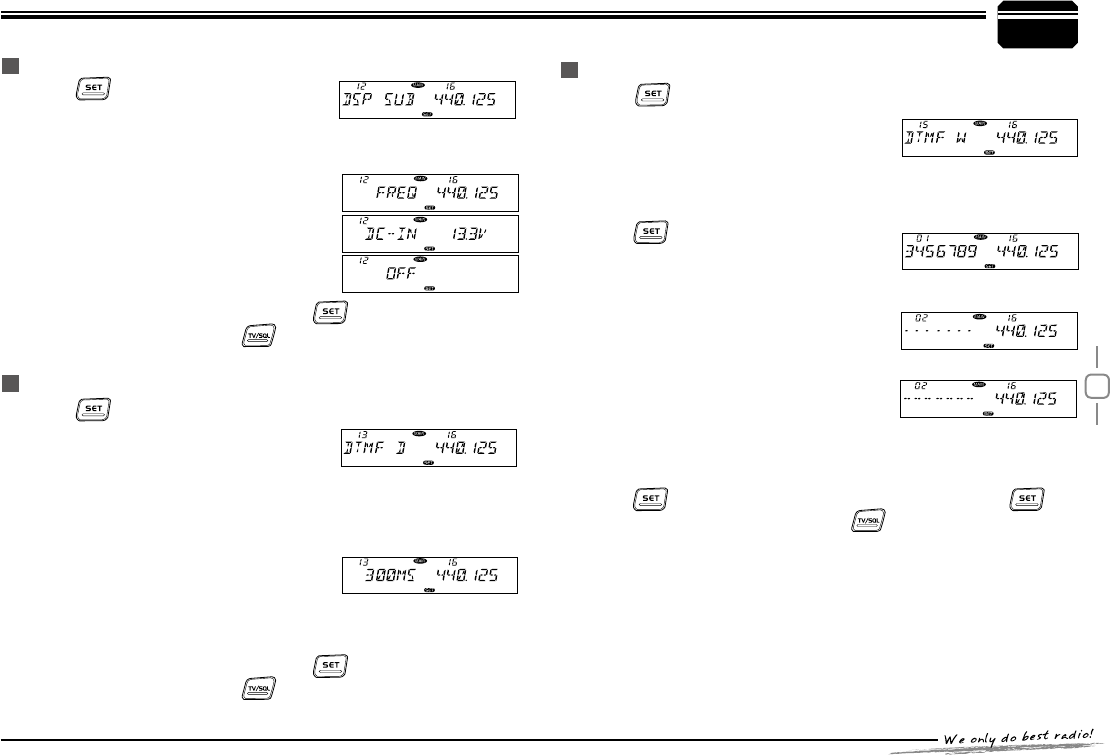
16
General Setting
Press
1. key to enter function menu.
Turn the Main band selector knob to
2.
choose No. 12 menu. the LCD displays "DSP SUB"
Press the Main band selector knob to enter function setup
3.
Switch the Main band selector knob to
4.
choose wanted value.
FREQ: display sub band frequency,
DC-IN: display sub band voltage.
OFF: turn off display for sub Band
Press the Main band selector knob or
5. key to store value and
back to function menu. Press key or hold selector knob for over
0.5 second to store setup and exit.
Press
1. key to enter function menu.
Turn the Main band selector knob to
2.
choose No. 13 menu. the LCD displays
"DTMF D".
Press the Main band selector knob to enter function setup
3.
Switch the Main band selector knob to choose wanted value.
4.
100MS: The Pre-Loading time is 100MS
300MS: The Pre-Loading time is 300MS
500MS: The Pre-Loading time is 500MS
800MS: The Pre-Loading time is 800MS
1000MS: The Pre-Loading time is 1000MS
Press the M
5. ain band selector knob or key to store value and
back to function menu. Press key or hold selector knob for over
0.5 second to store setup and exit.
SUB BAND DISPLAY SETUP
DTMF ENCODE PRE-LOADING TIME
7
Press
1. to enter function menu
Switch the Main band selector knob to
2.
choose No.15 menu, the LCD displays
"DTMF W".
Press the Main band selector knob to enter function setup.
3.
Switch the Mai
4. n band selector knob to choose DTMF group. Then
press key back to DTMF menu.
01-16: total 16 group of DTMF code.
DTMF ENCODE SETUP
When the selected group is empty, the
5.
LCD displays '------".
Press the selector knob to enter the DTMF signaling edit. The LCD
6.
display "-- -- -- -- -- --", the last character
ashes.
Switch the selector knob to choose wanted character. Press the
7.
selector knob to confirm selected value and start edit for next
character.
Press
8. key to store value and exit code editing. Press key
again to store setup and exit. Press key or hold selector knob
for over 0.5 second to store setup and exit.
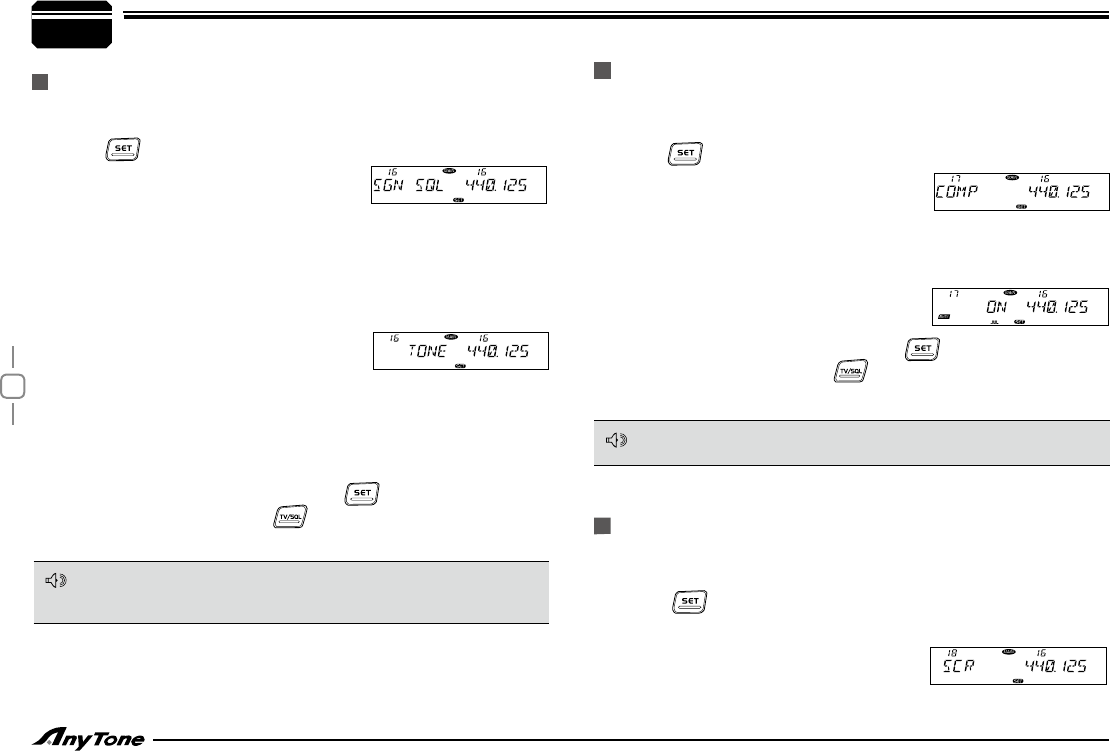
17
General Setting
This transceiver has 5 squelch modes available. Squelch function is used
for increase the level of ltering unwanted signal, and free from disturb.
Press
1. key to enter function menu.
Turn the Main band selector knob to choose
2.
No.16 menu. The LCD displays "SGN SQL"
Press the Main band selector knob to enter function setup.
3.
Switch the Main band selector knob to choose wanted value.
4.
SQ: You can hear the calling once receives matching carrier.
CTSS/DCS: You can hear the calling when receives matching carrier
and CTCSS/DCS code.
TONE: You can hear the calling when
receives matching carrier +
optional signaling.
CT*TO: You can hear the calling when receives matching carrier +
CTCSS/DCS + optional signaling.
CT/TO: You can hear the calling when receives any matching carrier
or CTCSS/DCS or optional signaling.
SQUELCH MODE SETUP
7
Press the Main band selector knob or
5. key to store value and
back to function menu. Press key or hold selector knob for over
0.5 second to store setup and exit.
Only when the transceiver is set with CTCSS/DCS or optional
DTMF/5TONE/TONE signaling, the values will be available.VHF2 no
optional DTMF/5TONE/2TONE signaling decode setup.
NOTE
Compander function will decrease the background noise and enhance
audio clarity, especially in long range communication.
Press
1. key to enter function menu
Turn the Main band selector knob to
2.
choose No 17 menu. The LCD displays
"COMP"
Press the Main band selector knob to enter function setup.
3.
Switch the Main band selector knob to choose wanted value.
4.
ON: Compander function is turn on
OFF: Compander function is turn off
Press the Main band selector knob or
5. key to store value and
back to function menu. Press key or hold selector knob for over
0.5 second to store setup and exit.
This special audio process can offer a more condential communication;
other radio with same frequency will receive only disordered noises.
Press
1. key to enter function menu.
Turn the Main band selector knob to choose No.18 menu. The LCD
2.
displays "SCR".
COMPANDER
SCRAMBLER SETUP
When using compander, to avoid distortion during communications, both
radios need turn on this function.
NOTE
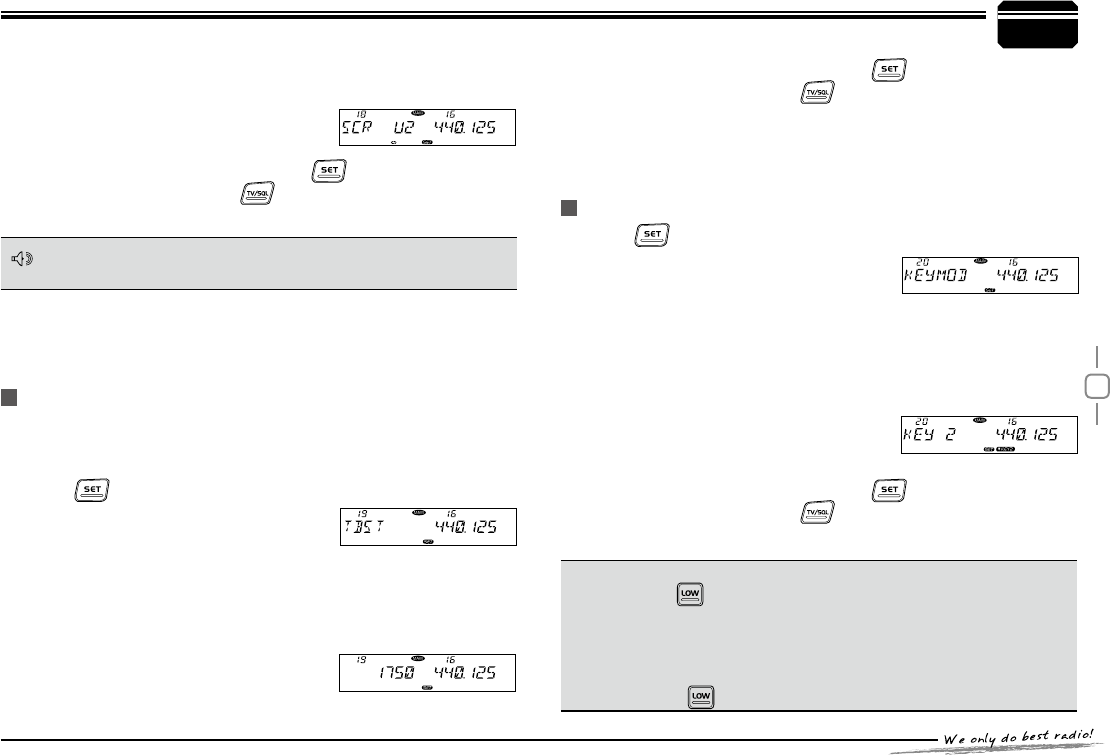
18
General Setting
This function uses to start repeater. It needs certain intensity Pilot
Frequency to start a dormant repeater. As usual, no need to send pilot
frequency again once repeater started.
Press
1. key to enter function menu.
Turn the Main band selector knob to
2.
choose No.19 menu. The LCD displays
"TBST".
Press the Main band selector knob to enter function setup.
3.
Switch the Main band selector knob to choose wanted frequency.
4.
1000: Pilot Frequency is 1000Hz.
1450: Pilot Frequency is 1450Hz.
1750: Pilot Frequency is 1750Hz.
2100: Pilot Frequency is 2100Hz.
TONE BURST (PILOT FREQUENCY)
To enable communication with scrambler, 2 transceivers shall set with
same group.
Press the Main band selector knob to enter function setup.
3.
Switch the Main band selector knob to choose wanted group
4.
1-9 (9 fix groups) U1, U2 (2 self defined
scrambler groups), OFF.
Press the Main
5. band selector knob or key to store value and
back to function menu. Press key or hold selector knob for over
0.5 second to store setup and exit.
7
NOTE
Press the Main band selector knob or
5. key to store value and
back to function menu. Press key or hold selector knob for over
0.5 second to store setup and exit.
Left long press: In standby, long press this key to add/
delete optional signaling, repeat the long press it will set
optional signaling DTMF, 5TONE or 2TONE. When the LCD
displays DT means DTMF, displays 5T means 5TONE,
displays 2T means 2TONE.
Right Short press: In VFO mode, short press this key,
Press
1. key to enter function menu.
Turn the Main band selector knob to
2.
choose No.20 menu. The LCD displays
"KEYMOD".
Press the Main band selector knob to enter function setup.
3.
Switch the Main band selector knob to choose wanted mode.
4.
KEY1: key1 mode, Normal mode, the left 4 keys have same functions
as the right 4 keys.
KYE2: the left 4 keypads will shared by
both band. And the right 4 key
pads will be re-dened.
Press the Main band selector knob or
5. key to store value and
back to function menu. Press key or hold selector knob for over
0.5 second to store setup and exit.
KEYPAD MODE SETUP
Notice: Denition of Keypad in KEY2 mode:
1.
2.
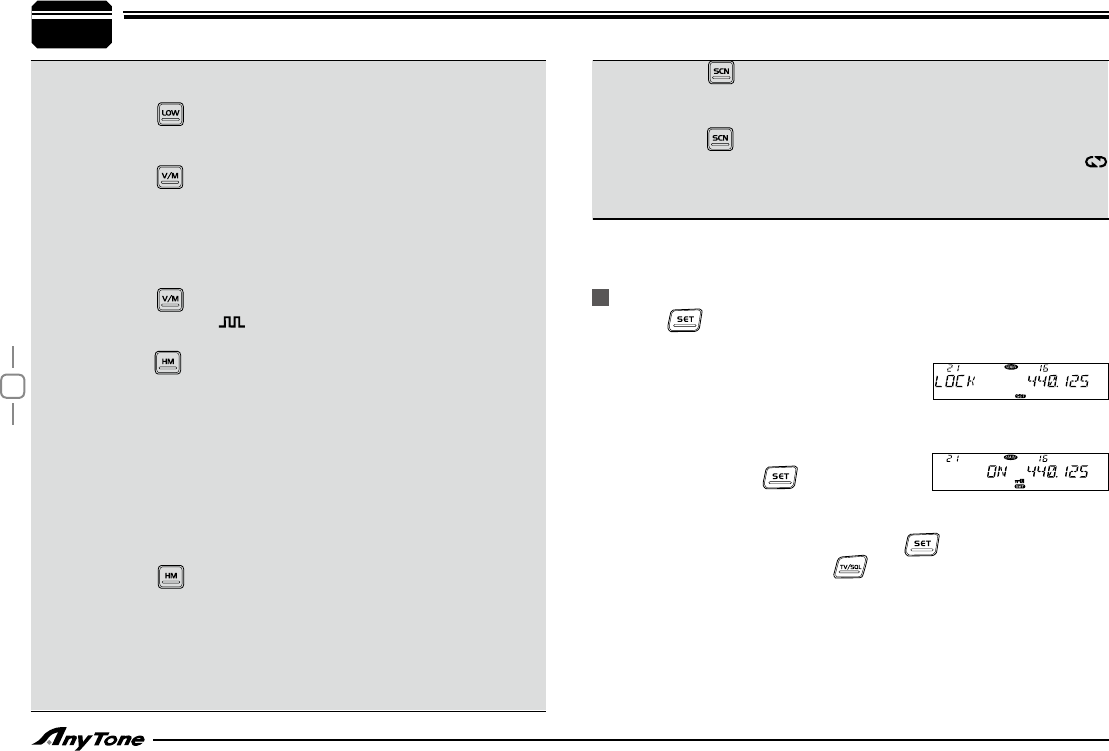
19
General Setting
the frequency step size changes to 1Mhz, in channel mode,
adjust selector knob will jump 10 channels.
Right long press: Talk Around. When this function is
activated, transceiver can not communicate with repeater.
Repeat the operation to turn off Talk Around.
Right short press: Frequency reverse function, when
current channel is setup with offset direction and offset
frequency, press this key will turn on frequency reverse
function.The signaling will also be reversed if CTCSS/DCS
signaling existed in this channel. Repeat the short press it
will turn off Frequency reverse function.
Right long press: In stand by, hold this key until the
LCD displays , means the compander function is on,
repeater above operation to turn off compander function.
Right short press: In standby, press this key to set the
CTCSS/DCS code for current channel.
When the LCD displays ENC, the current channel is with
CTCSS encode function.
When the LCD displays ENC and DEC, the current channel
is with CTCSS /DCS code function.
When the LCD displays DCS and DCS icon, the current
channel is with CTCSS code function.
When the LCD displays OFF, the current channel is without
CTCSS /DCS function.
Right long press: In standby, long press this key to
enter CTCSS/DCS scan, when nd matching CTCSS/DCS
signal, the scan will pause in the way following Scan Dwell
time.The scan direction can be changed by corresponding
channel selector knob. Note:To enable this function, the
channel shall be set up with CTCSS/DCS decode.
7
3.
4.
5.
6.
7.
Press
1. key to enter function menu.
Turn the Main band selector knob to choose No.21 menu. The LCD
2.
displays "LOCK".
Press the Main band selector knob to
3.
enter function setup.
Switch the Main band selector knob to choose wanted mode.
4.
ON: The keypad lockout function is turn
on, all keys beside and band switch
knobare invalid.
OFF: The keypad lockout function is turn off.
Press the Main band selector knob or
5. key to store value and
back to function menu. Press key or hold selector knob for over
0.5 second to store setup and exit.
KEYPAD LOCKOUT
Right short press, shot press this key, the sub band will
display "MAIN" and ashes.In this case, you can setup for sub
band without switch between Main band and Sub band.
Right long press, choose scrambler group for Main band.
In standby, hold this key, the LCD displays SCR X and
icon. X stands for the group number, repeater above operation
to choose wanted group.
8.
9.
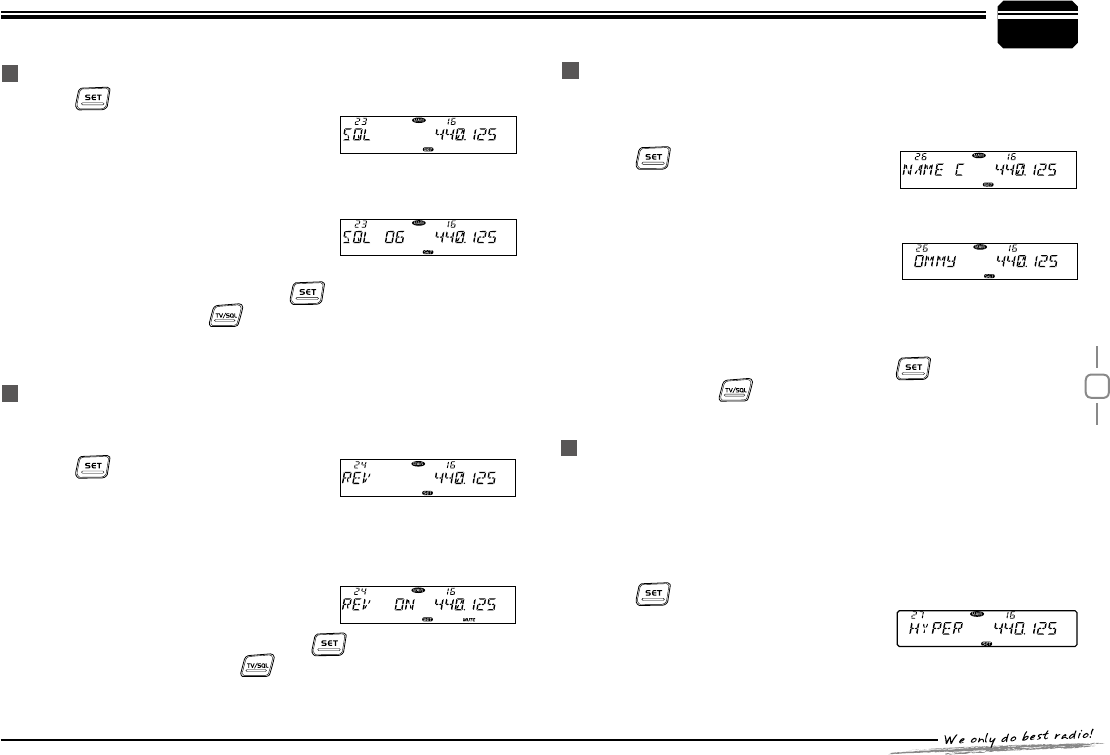
20
7
General Setting
Press
1. key to enter function menu.
Turn the Main band selector knob to
2.
choose No.23 menu. The LCD displays
"SQL".
Press the Main band selector knob to enter function setup.
3.
Switch the Main band selector knob to choose wanted value
4.
1-20: total 20 squelch levels
OFF: Turn off squelch function, the
background noise keep on.
Press the Main band selector knob or
5. key to store value and back
to function menu. Press key or hold selector knob for over 0.5
second to store setup and exit.
With this function on, the transceiver will be able to communicate with a
transceiver in same network without through a repeater.
Press
1. key to enter function menu.
Turn the Main band selector knob to
2.
choose No 24 menu. The LCD displays "REV"
SQUELCH LEVEL SETUP
FREQUENCY REVERSE
Press the Main band selector knob to enter function setup.
3.
4. Switch the Main band selector knob to choose wanted value.
ON: Frequency Reverse is turn on.
OFF: Turn off Frequency Reverse.
Press the Main band selector knob or key to store value and
back to function menu. Press key or hold selector knob for over
0.5 second to store setup and exit.
5.
Press
1. to enter function menu
Turn the Main band selector knob to
2.
choose NO.27 menu, the LCD displays
"HYPER".
Press the Main band selector knob to enter function setup.
3.
EDITING CHANNEL NAME
After edit a name for a channel, if the display mode is channel name, the
will display the name edited in this menu. Otherwise it will display the
frequency.
Press
1. key to enter function menu.
Switch the selector knob to choose NO.26
2.
function menu, the LCD displays "NAME C".
Press the Main band selector knob to enter function setup.
3.
Switch the selector knob to choose
4.
wanted character.
Press the selector knob to conrm current character and start edit
5.
next character, after editing all 7 characters, press the selector knob
to conrm and back to function menu.
If the editing not reach 7 characters, press
6. key back to function
menu, then press key or hold selector knob for over 0.5 second
to store setup and exit.
CHANNEL FUNCTION AUTO STORAGE SETUP
This function is used to store lastest setup for each single channel.
when this function is on, all the latest temporary operation for present
channel will be stored no matter change channel or power off radio.
when this function is off, the temporary setup will not be stored, the
channel informaiton will resume to the last stored value after change
channel or power off radio.
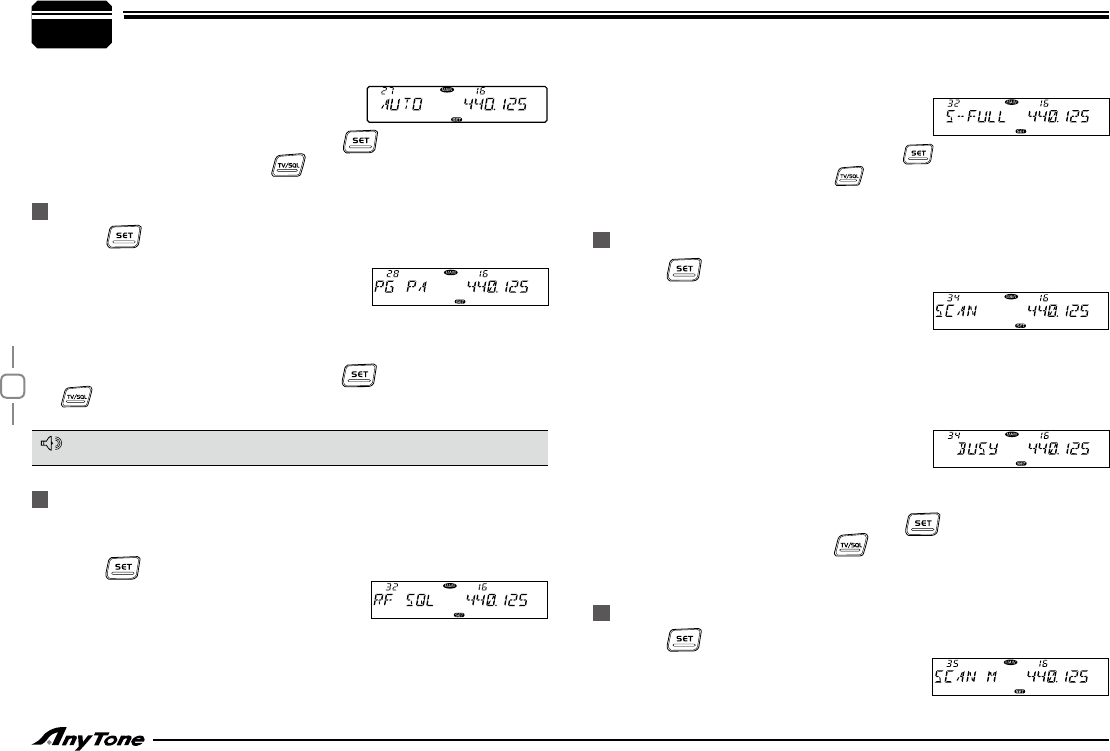
21
General Setting
7
Press
1. key to enter function menu.
Turn the Main band selector knob to
2.
choose No.28-31 menu. The LCD displays
"PG PA", "PG PB", "PG PC", "PG PD".
Press the Main band selector knob to enter function setup.
3.
4. Switch the Main band selector knob to choose wanted value.
5. Press the Main band selector knob or key to store value and
back to function menu. Press key or hold selector knob for over
0.5 second to store setup and exit.
MICROPHONE PA,PB, PC,PD KEY SETUP
For Menu details, please refer to Page 30-31, Microphone Operation.
NOTE
RF SQUELCH LEVEL SETUP
When squelch level function is on, you can cancel squelch only when the
signal strength reach the level setup by users.
Press
1. key to enter function menu.
Turn the Main band selector knob to
2.
choose No.32 menu. The LCD displays
"RF SQL".
Press the Main band selector knob to enter function setup.
3.
Switch the Main band selector knob to choose wanted value.
4.
S-2: Able to hear the calling when the power meter reach 1 bar.
Switch the Mian band selector knob to choose wanted value.
4.
MANUAL: Auto storage is turn off.
AUTO: Auto storeage is turn on.
Press the Main band selector knob or
5. key to store value and
back to function menu. Press key or hold selector knob for over
0.5 second to sore setup and exit.
Press
1. key to enter function menu.
Turn the Main band selector knob to
2.
choose No.34 menu. The LCD displays
"SCAN".
Press the Main band selector knob to enter function setup.
3.
SCAN DWELL TIME SETUP
S-5: Able to hear the calling when the power meter reach 4 bar.
S-9: Able to hear the calling when the power meter reach 8 bar.
S-FULL: Able to hear the calling when the
power meter reach full bar.
Press the Main band selector knob or
5. key to store value and
back to function menu. Press key or hold selector knob for over
0.5 second to store setup and exit.
Press
1. key to enter function menu.
Turn the Main band selector knob to
2.
choose No.35 menu. The LCD displays
"SCAN M".
PRIORITY CHANNEL SCAN
Switch the Main band selector knob to choose wanted value.
4.
TIME: it pauses 5s once scanning a matching signal, then resume scan.
BUSY: it pauses once scanning a
matching signal, then resume scan after
the signal disappeared for 2 seconds.
SECEDE: It Stops once scanning a matching signal, and exit scan.
Press the Main band selector knob or
5. key to store value and
back to function menu. Press key or hold selector knob for over
0.5 second to store setup and exit.
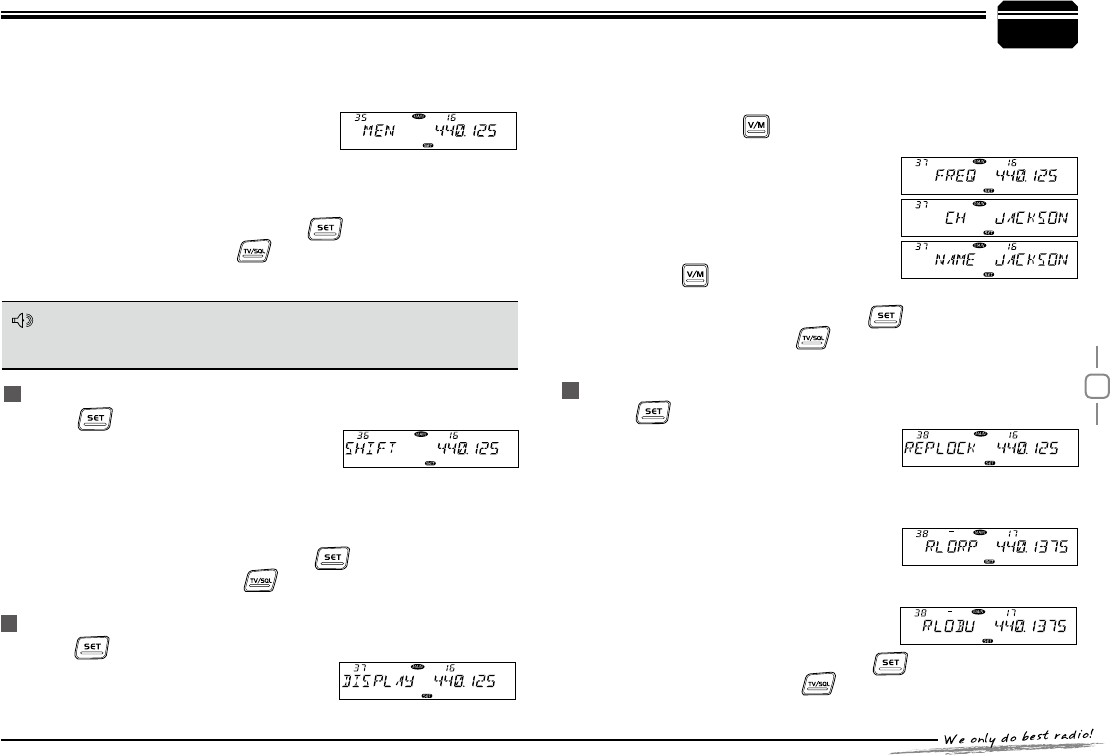
22
General Setting
Press
1. key to enter function menu.
Turn the Main band selector knob to choose
2.
No.36 menu. The LCD displays "SHIFT".
Press the Main band selector knob to enter function setup.
3.
Switch the Main band selector knob to choose wanted value.
4.
Available Offset frequency for this transceiver is 0-100MHz.
Press the Main band selector knob or
5. key to store value and
back to function menu. Press key or hold selector knob for over
0.5 second to store setup and exit.
OFFSET FREQUENCY SETUP
Before using Priority channel scan function.the edited channel shall be set
up as "P SCAN" or refer to the PRI instrunction in page 29 to add or delete
priority channel.
NOTE
7
Press the Main band selector knob to enter function setup.
3.
Switch the Main band selector knob to choose wanted value.
4.
MEN: Channel Scan, the transceiver will
scan all the channels after enter channel
scan.
MSN: Priority Channel Scan, the transceiver will only scan the priority
channel after enter channel scan.
Press the Main band selector knob or
5. key to store value and
back to function menu. Press key or hold selector knob for over
0.5 second to store setup and exit.
Press
1. key to enter function menu.
Turn the Main band selector knob to
2.
choose No.37 menu. The LCD displays
"DISPLAY".
DISPLAY MODE SETUP
Press
1. key to enter function menu.
Turn the Main band selector knob
2. to
choose No.38 menu. The LCD displays
"REPLOCK".
Press the Main band selector knob to enter function setup.
3.
Switch the Main band selector knob to choose wanted value.
4.
RLORP: Signaling busy lockout, when current
channel receives a matching carrier
but dis-matching CTCSS/DCS.
RLOBU: Channel busy lockout, when current channel receives a
matching carrier;
OFF: Busy channel lockout is disabled.
Press the Main band selector knob or
5. key to store value and
back to function menu. Press key or hold selector knob for over
0.5 second to store setup and exit.
BUSY CHANNEL LOCKOUT
Press the Main band selector knob to enter function setup.
3.
Switch the Main band selector knob to choose wanted value.
4.
FREQ: The radio displays channel number + frequency in channel
mode, if press key,it will change to VFO mode.
CH: Displays only channel number.
NAME: In channel mode, It displays the
channel number and channel name
if the current channel is set up with
a name. Otherwise, it display the
channel number and frequency.If
press key, it will change to VFO
mode.
Press the Main band selector knob or
5. key to store value and
back to function menu. Press key or hold selector knob for over
0.5 second to store setup and exit.
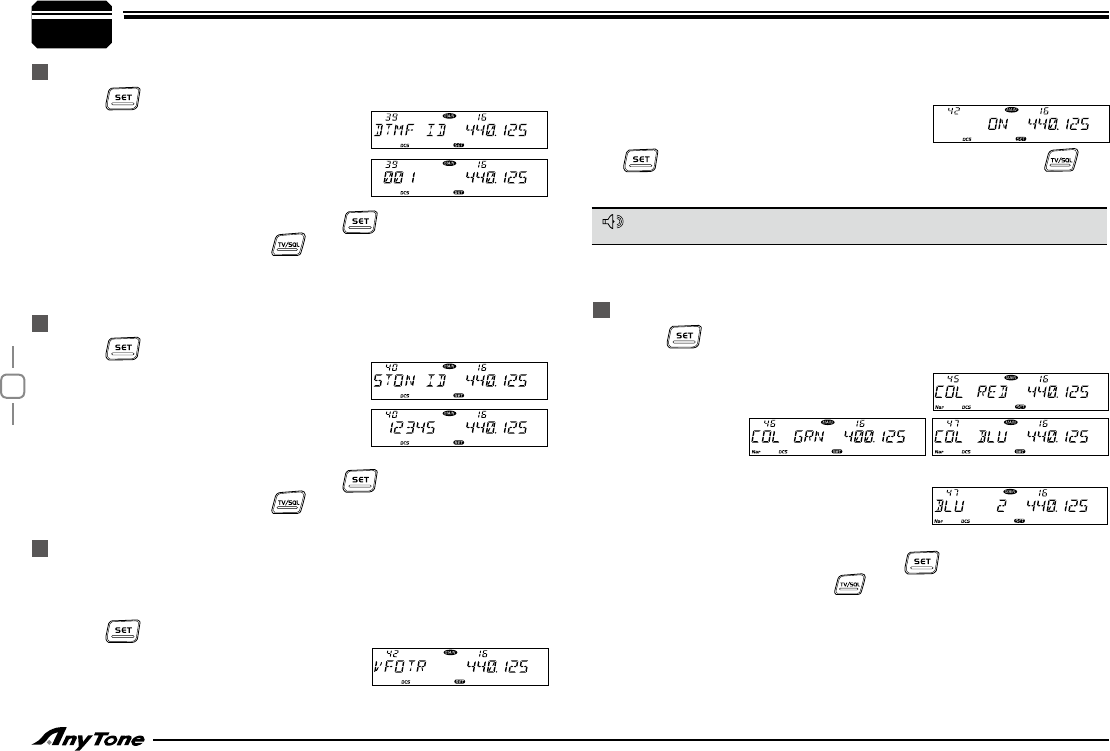
23
General Setting
RADIO'S DTMF SELF ID ENQUIRY
Press
1. key to enter function menu.
Switch the selector knob to choose No. 39
2.
function. The LCD displays "DTMF ID".
Press the Main band selector knob to
3.
enter function setup. The LCD will show
the DTMF self ID.
Press the Main band selector knob or
4. key to store value and
back to function menu. Press key or hold selector knob for over
0.5 second to store setup and exit.
Press
1. key to enter function menu.
Switch the selector knob to choose No.40
2.
function. The LCD displays "5TONE ID".
Press the Main band selector knob to
3.
enter function setup. The LCD will show
the 5TONE self ID.
Press the Main band selector knob or
4. key to store value and
back to function menu. Press key or hold selector knob for over
0.5 second to store setup and exit.
5TONE SELF ID ENQUIRY Press
1. key to enter function menu.
Turn the Main band selector knob to choose No. 45-47 menu.
2.
The LCD displays "COL RED","COL
GRN","COL BLU".
LCD BACKLIGHT
This function is only valid when both bands work on VFO mode.
NOTE
Enable this function, the adjustment for any band of VFO frequency,
will bring same frequency change to both bands. Adjust one gear, the
frequency for both bands will increase or decrease one step size value.
Press
1. key to enter function menu.
Turn the Main band selector knob to
2.
choose No.42 menu. The LCD displays
"VFOTR".
VFO FREQUENCY LINKAGE
Press the Main band selector knob to enter function setup.
3.
Switch the Main band selector knob to
4.
choose wanted value.Each color (Red,
blue, Green) with 32 brightness levels.
Press the Main band selector knob or
5. key to store value and
back to function menu. Press key or hold selector knob for over
0.5 second to store setup and exit.
7
Press the Main band selector knob to enter function setup.
3.
Switch the Main band selector knob to choose wanted value.
4.
Available Values: ON, OFF.
Press the Main band selector knob or
5.
key to store value and back to function menu. Press key
or hold selector knob for over 0.5 second to store setup and exit.
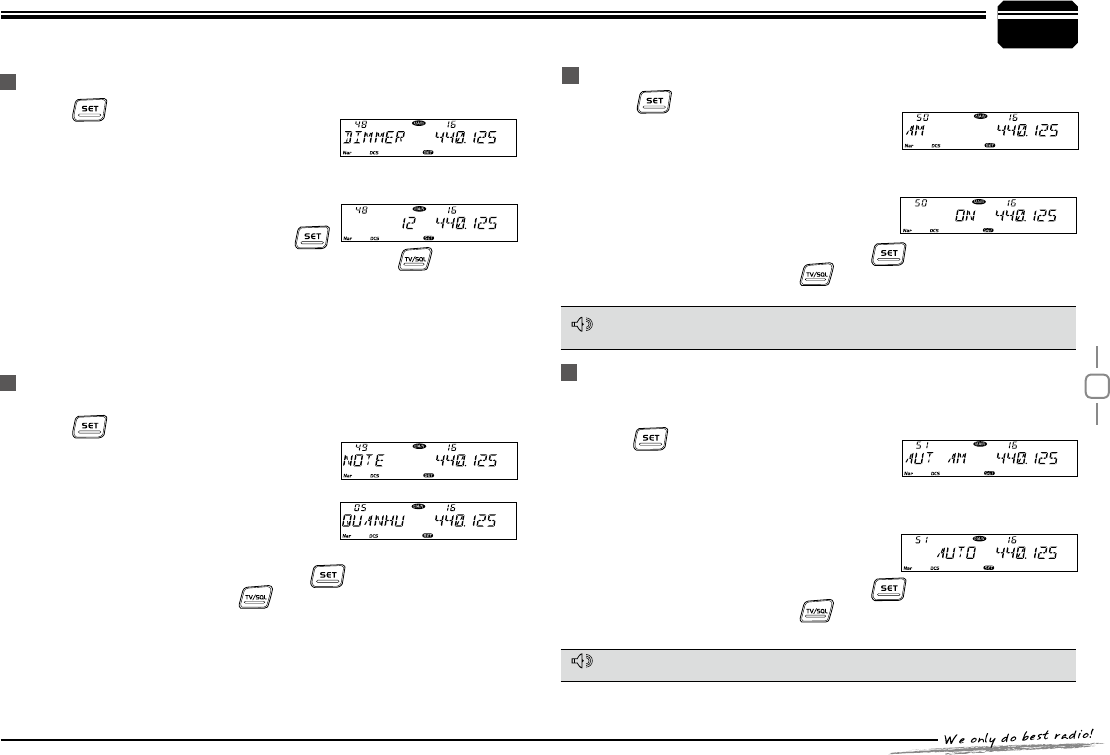
24
7
General Setting
The transceiver offers enquiry of calling record.
Press
1. key to enter function menu.
Turn the Main band selector knob
2. to choose
No. 49 menu. The LCD displays "NOTE".
Press the Main band selector knob to enter function setup.
3.
Switch the Main band selector knob to
4.
choose wanted value.
This transceiver is able to record 16 calling at most.
Press the Main band selector knob or
5. key to store value and
back to function menu. Press key or hold selector knob for over
0.5 second to store setup and exit.
CALLING RECORD
Press
1. key to enter function menu.
Turn the Main band selector knob to choose
2.
No. 50 menu. The LCD displays "AM".
Press the Main band selector knob to enter function setup.
3.
Switch the Main band selector knob to choose wanted value.
4.
AM FUNCTION
Press
1. key to enter function menu.
Turn the Main band selector knob to choose
2.
No. 48 menu. The LCD displays "DIMMER".
Press the Main band selector knob to enter function setup.
3.
Switch the Main band selector knob to choose wanted value.
4.
Available value: 32 brightness levels.
Press the Main band selector knob or
5.
key to store value and back to function menu. Press key or hold
selector knob for over 0.5 second to store setup and exit.
KEYPAD BACKLIGHT BRIGHTNESS
This function is only valid when the Main band frequency is VHF 108-
180MHz, the function is invalid when the right band is set as Main band.
NOTE
AUTOMATIC AM FUNCTION
To enable Automatic AM function, the AM function shall be turned on rst.
The radio will automatically boot AM function when the VHF frequency is
under 136Mhz.
Press
1. key to enter function menu.
Turn the Main band selector knob to choose
2.
No. 51 menu. The LCD displays "AUT AM".
Press the Main band selector knob to enter function setup.
3.
Switch the Main band selector knob to choose wanted value.
4.
ON: turn on auto AM function.
OFF: turn off auto AM function.
Press the Main band selector knob or
5. key to store value and
back to function menu. Press key or hold selector knob for over
0.5 second to store setup and exit.
NOTE
ON: turn on AM function.
OFF: turn off AM function.
Press the Main band selector knob or
5. key to store value and
back to function menu. Press key or hold selector knob for over
0.5 second to store setup and exit.
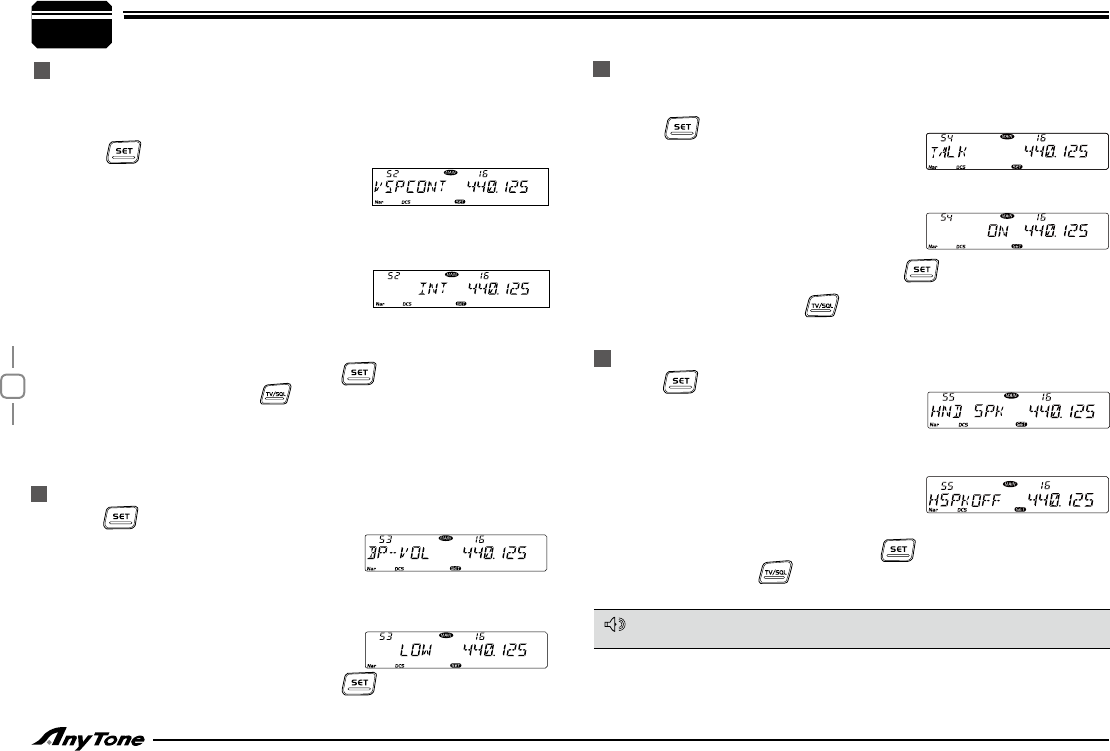
25
7General Setting
TALK AROUND
MICROPHONE SPEAKER
When turn on microphone speaker, please set up Menu 52 VSPCONT to
be INT, otherwise the VHF signal can not be monitored.
NOTE
BEEP VOLUME CONTROL
1. Press key to enter function menu.
2. Turn the Main band selector knob to
choose No. 53 menu. The LCD displays
“BP-VOL”.
3. Press the Main band selector knob to enter function setup
4. Switch the Main band selector knob to choose wanted value.
LOW: BEEP volume is low.
HIGH: BEEP volume is high.
5. Press the Main band selector knob or key to store value and
back to function menu.
Press the Main band selector knob to enter function setup.
3.
Switch the Main band selector knob to choose wanted value.
4.
INT: Use main internal speaker, the sub
internal speaker will be shut off. VHF and
UHF band share main speaker
EXT: Use sub internal speaker or external speaker, the VHF calling can
be heard from the sub speaker or external speaker.
Press the Main band selector knob or
5. key to store value and
back to function menu. Press key or hold selector knob for over 0.5
second to store setup and exit.
1. Press key to enter function menu.
2. Turn the Main band selector knob to choose
No.55 menu. The LCD displays “HND SPK” .
3. Press the Main band selector knob to enter function setup.
4. Switch the Main band selector knob to choose wanted value
HSPKOFF: Turn off microphone speaker.
HSPK ON: Turn on microphone speaker.
MSPKOFF: Turn off Main speaker.
5. Press the Main band selector knob or key to store value and back
to function menu.Press key or hold selector knob for over 0.5 second
to store setup and exit.
With this function on, the transceiver will not able to communicate with
another transceiver through a repeater.
1. Press key to enter function menu.
2. Turn the Main band selector knob No.54
menu. The LCD displays “TALK”.
3. Press the Main band selector knob to enter function setup.
4. Switch the Main band selector knob to choose wanted value
ON: Turn on Talk Around
OFF: Turn off Talk Around
5. Press the Main band selector knob or key to store value and
back to function menu. Press key or hold selector knob for over 0.5
second to store setup and exit.
VHF EXTERNAL SPEAKER PORT
When the function setup as external (EXT), in order to hear the calling on
VHF, user can use sub speaker or connect an external dual track speaker
(SP-02). The calling from VHF and UHF are separated in 2 tracks.
Press
1. key to enter function menu.
Turn the Main band selector knob to
2.
choose No. 52 menu. The LCD displays
"VSPCONT".
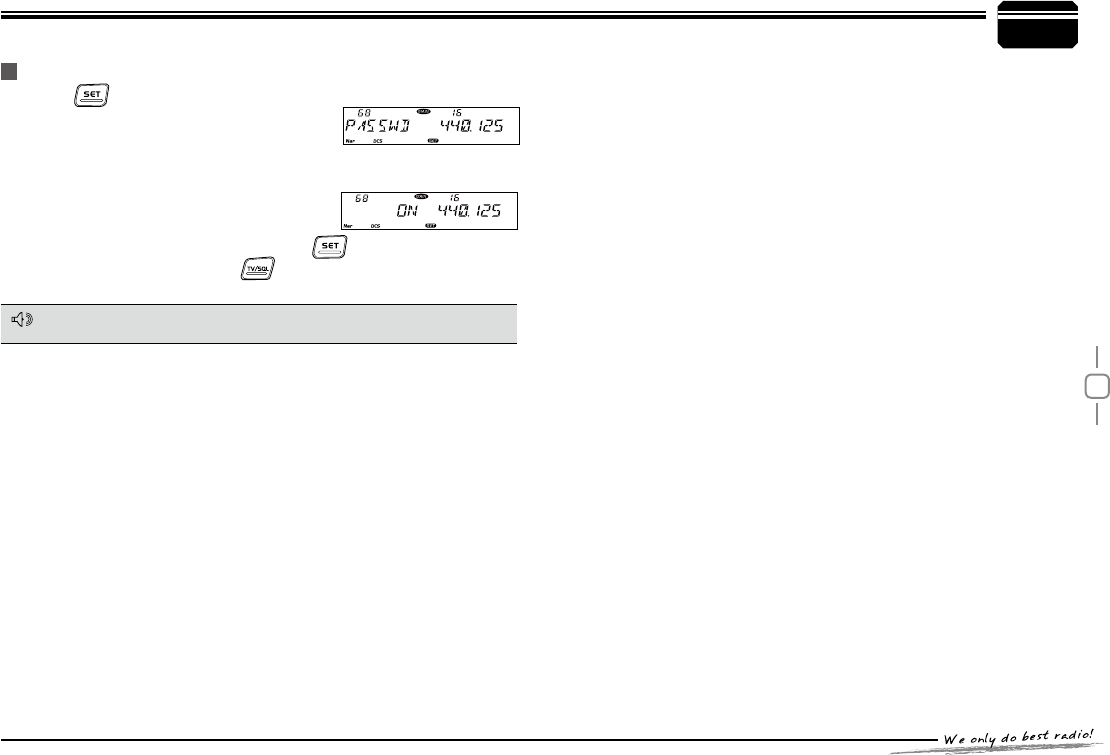
26
7
General Setting
Press
1. key to enter function menu.
Turn the Main band selector knob to choose
2.
No.68 menu. The LCD displays "PASSWD".
Press the Main band selector knob to enter function setup.
3.
Switch the Main band selector knob to choose wanted value.
4.
ON: Turn on password function.
OFF: Turn off password function.
Press the Main
5. band selector knob or key to store value and
back to function menu. Press key or hold selector knob for over
0.5 second to store setup and exit.
PASSWORD FUNCTION
When password function is on, correct password shall be input after power
on. The password shall be set up before using this function.
NOTE
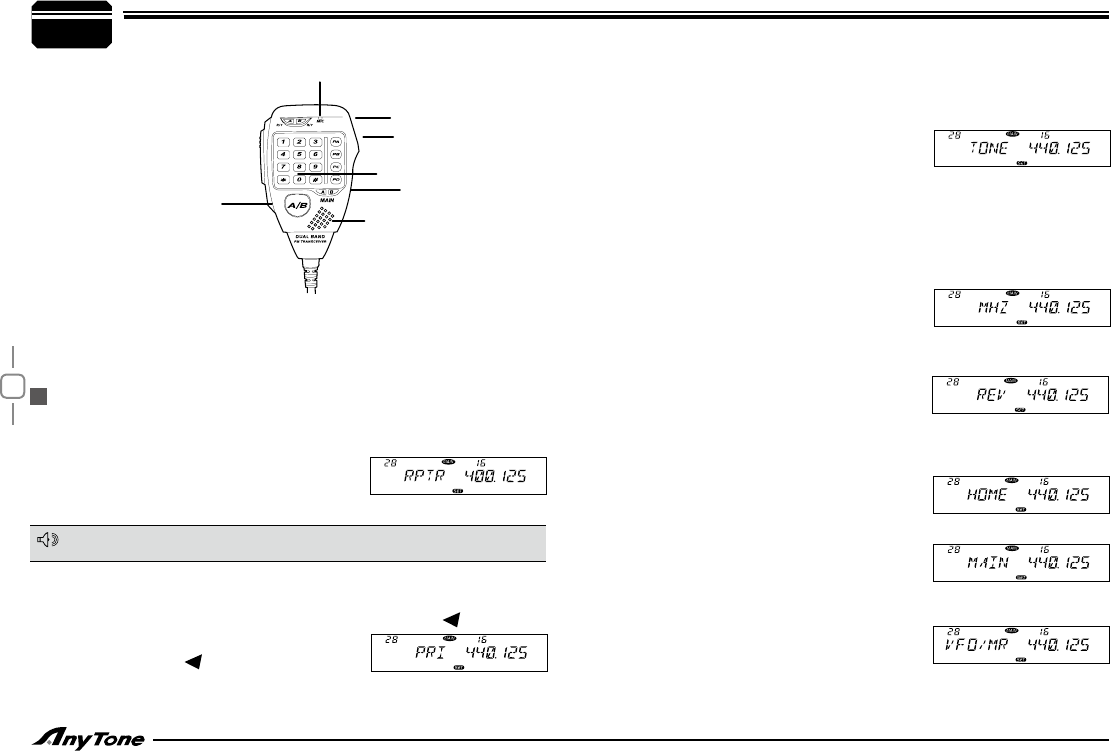
27
8Microphone Operation
FUNCTION OPERATION THROUGH PA-PD KEYS
You can operate the transceiver by keypad or input desired frequency
and channel through the QHM-05 microphone.
This function is valid only when current channel set with offset frequency.
PRI:Add or delete priority channel: In channel mode, press the key PRI
function to set priority channel, when the LCD displays the current
channel is set as priority channel. Repeat
above operation, the disappear, the curent
channel is not set as priority channel.
The PA, PB, PC, PD, keys can be set up with the following functions.
RPTR: OFFSET direction setup, in standby, press the key RPTR function
will change the offset direction. When LCD
displays"+", means plus offset, when the LCD
displays"-", means minus offset.
NOTE
Main/Sub band switch
UP
DOWN
MIC
Numeric Keys
UP/DOWN lock key
Microphone speaker
REV: In standby, press the key "REV" function
to turn-on or turn off Frequency Revrse
function.
HOME: HOME channel switch, in standby press the key "HOME" function
to switch between HOME channel and current
channel.
MAIN: Main band switch, in standby press
the key "MAIN" function to choose left band or
right band as Main band.
VFO/MR: Working mode switch, in standby,
press the key "VFO/MR" function to switch
between channel mode and frequency mode.
TONE: CTCSS/DCS code setup. In standby, press the key TONE function
will be able to setup CTCSS/DCS code. When the LCD displays "ENC"
and CTCSS frequency, press the [ UP/DOWN ] key to choose CTCSS
encode. When the LCD displays "ENC", "DEC"
and CTCSS frequency, press the microphone
[ UP/DOWN ] key to choose CTCSS decode.
When the LCD displays "DCS" and DCS code, press the microphone [
UP/DOWN ] key to choose DCS code.
MHZ: In VFO mode, press the key MHZ function, the megabit digital in the
LCD ashes, now turn the channel knob or microphone [ UP/DOWN ] key
to adjust frequency by 1Mhz step. In channel mode, press this key, the
channel number flashes, now adjust selector
knob or microphone [ UP/DOWN ] key to
adjust channel.
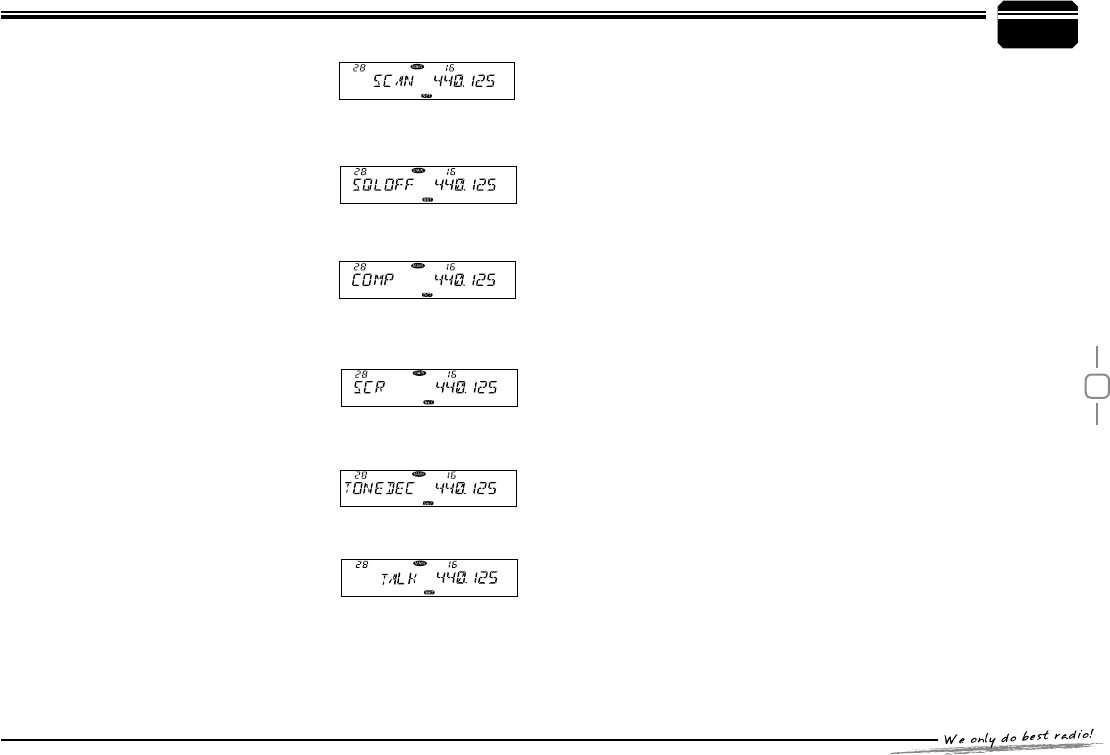
28
8
Microphone Operation
COMP: Compander function in standby,
press the key "COMP" to turn on or turn off
Compander function.
SCR: Scrambler function, in standby, press the key "SCR" function to turn
on or turn off Scrambler function. And choose
optional scrambler groups (from 9 xed groups
and 2 self dened groups).
TONE DEC: Add Optional Signaling, in standby press the key "TONE DEC"
function to choose DTMF(DT), 2TONE(2T),
5TONE(5T) or OFF.
TALK: In standby status, press Talk key to enable and disable Talk
around function.
OFF: No function.
SCAN: scan function, in standby, press the
key "SCAN" function to start channel scan or
frequency scan.
SQL OFF:Turn off Squelch, in standby, press the key "SQL OFF" function
to turn off squelch, you can hear very weak
signal, repeat the above function to turn on
squelch.
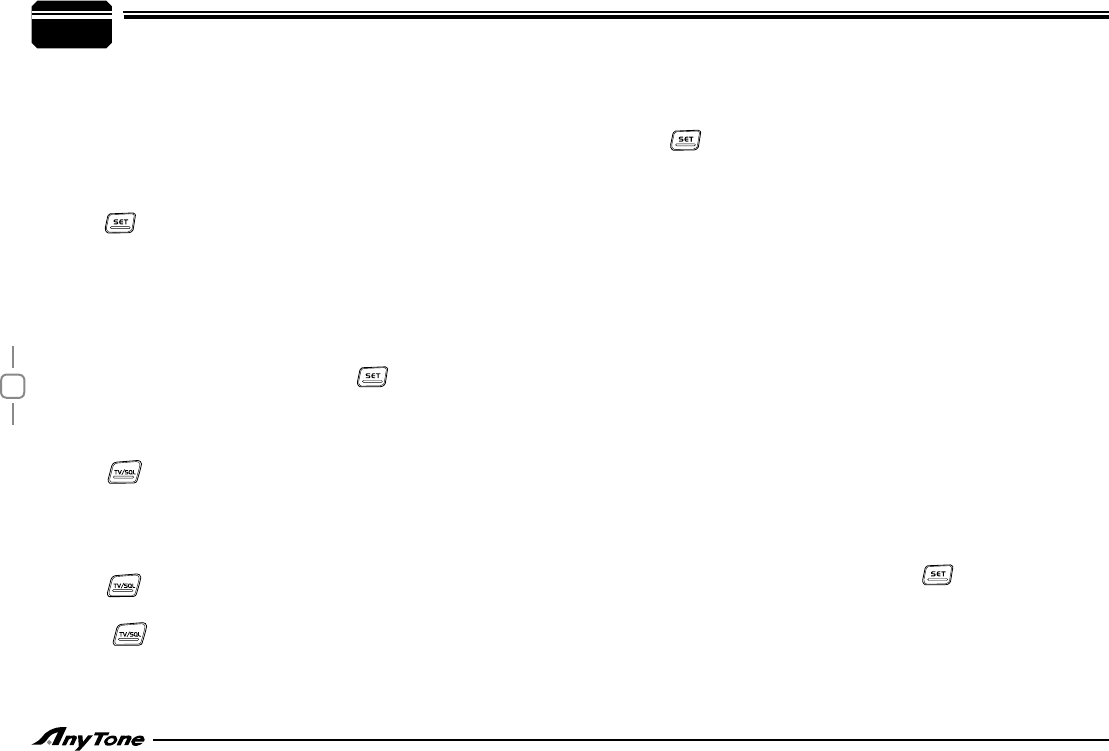
29
Memory Banks
9
10 memory banks are available for memory channel assignments
to ease in operation of the 5888UV III tri-band radio. You can
enable one bank or multible banks through the radio itself.
1. Select memory channel to assign to a memory bank.
2. Press key to enter function menu.
3. Turn the main band selector knob to choose No. 56 menu.
The LCD displays "BAK"
4. Press the main band selector knob to enter function setup.
5. Switch the main band selector knob to choose desired value.
OFF: No bank assignment
A, B, C, D, E, F, G, H, I, J to assign the selected bank.
6. Press the main band selector knob or key to store.
1. Select either left or right band in memory mode.
2. Press key to enter bank mode.
3. Bank numbers show in the position of channel number. If a
channel number is not assigned, a bank "--" will show; otherwise
the assigned bank of that channel will show.
4. Rotate the selector knob to choose desired bank to view.
5. Press key to conrm. Radio will swich to chosen bank.
You can now view or scan channels in choosen bank.
6. Press key two times to cancel bank view and return to
memory view.
Memory banks can be linked together for expanded scanning or
viewing.
1. Press key to enter function menu.
2. Turn the main band selector knob to choose No. 57 menu.
The LCD displays "BALK".
3. Press the main band selector knob to enter function setup.
4. Switch the main band selector knob to choose which banks
to link.
The following menus allow you to link banks A-J.
ON/OFF: Select ON to turn on Bank Linking, OFF to turn off
Bank Linking
Menu 58 Bank A Link ON /OFF
Menu 59 Bank B Link ON /OFF
Menu 60 Bank C Link ON /OFF
Menu 61 Bank D Link ON /OFF
Menu 62 Bank E Link ON /OFF
Menu 63 Bank F Link ON /OFF
Menu 64 Bank G Link ON /OFF
Menu 65 Bank H Link ON /OFF
Menu 66 Bank I Link ON /OFF
Menu 67 Bank J Link ON /OFF
5. Press the main band selector knob or key to store.
ASSIGNING A CHANNEL TO A MEMORY BANK
CHOOSING ACTIVE BANK
BANK LINKING
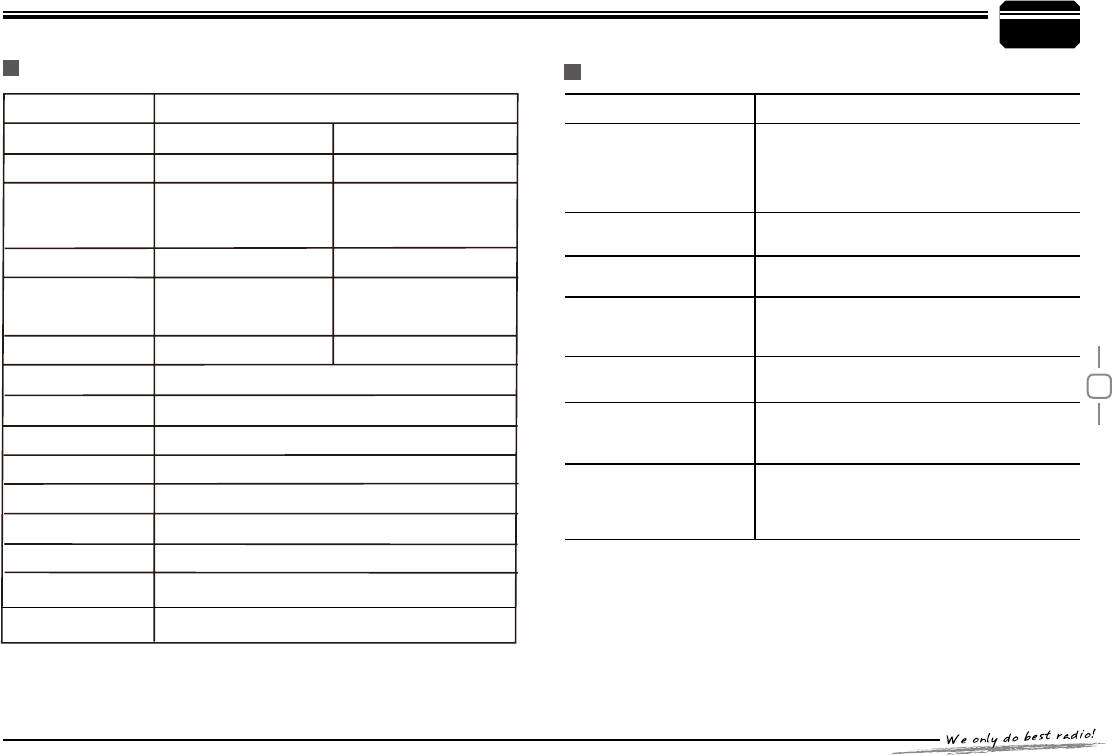
30
11 Maintenance
TROUBLE SHOOTING
Problem
+ and - polarities of power connection are
reversed. Connect red lead to plus terminal
and black lead to minus terminal of DC
power supply.
(b) Fuse is blown. Check and solve problem resulting in blown
fuse and replace fuse with new fuse.
(c) Display is too dim. Adjust the Dimmer to higher level.
Key-lock function is activated. Cancel Key-
lock function.
Transceiver is in CALL mode or VFO mode.
DEFAULT VALUE FOR FACTORY RESUME
(a) Power is on, nothing
appears on Display.
Possible Causes and Potential Solutions
(d) No sound comes
from speaker.
• Squelch is muted. Decrease squelch level.
• Tone or CTCSS/DCS squelch is active.
Turn CTCSS or DCS squelch off.
(e) Key and Dial do
not function.
(f) Rotating Dial will not
change memory
channel.
• Microphone connection is poor. Connect
microphone properly.
• Antenna connection is poor. Connect
antenna properly.
(g) PTT key is pressed
but transmission does
not occur.
5888UV III
Left band
VFO frequency
Memory channel
1-750
CH1: 144.000MHz
CH2: 222.000MHz
CH3: 420.000MHz
Offset direction
Offset frequency
Step size 12.5KHz
88.5Hz
017N
HI
OFF
OFF
CTCSS code --
CTCSS frequency
DCS code
DCS group
Output power
Key Lockout
TOT 3
4
APO
Squelch level
--
Right band
145.15MHz 435.15MHz
--
600KHz 5MHz
--
CH1: 144.000MHz
CH3: 420.000MHz
12
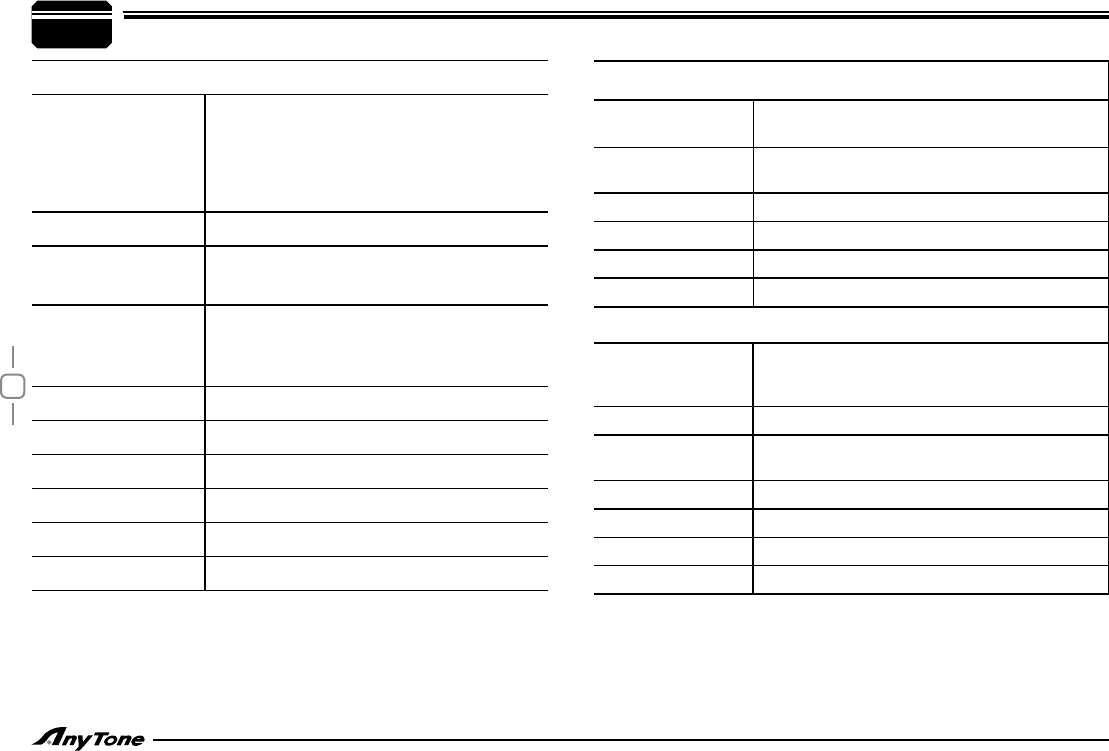
31
General
Frequency Range
RX: 136~174MHz
220~260MHz
400~512MHz
TX: 144~148MHz
222~225MHz
420~450MHz
Number of Channels 750 channels
Channel Spacing 12.5KHz
Phase-locked Step 2.5KHz,5KHz,6.25KHz,8.33KHz,10KHz,
12.5KHz,15KHz,20KHz,25KHz.
Operating Voltage 13.8V DC ±15%
Squelch Carrier/CTCSS/DCS/5Tone/2Tone/DTMF
Frequency Stability ±2.5ppm
Operating Temperature -20~+60℃
Dimensions(WxHxD) 140(W)x50(H)x210(D)mm
Weight about 1.38kg
Specifications 12
Receiver
Sensitivity
(12dB SINAD) ≤0.35μV
Adjacent Channel
Selectivity ≥60dB
Audio Response +1~-3dB(0.3~2.55KHz)
Hum & Noise ≥40dB
Audio distortion ≤5%
Audio power output >2W@10%
13
Transmitter
Power Output
50W/25W/10W/5W(VHF1)
25W/15W/10W/5W(VHF2)
40W/25W/10W/5W(UHF)
Modulation 11KΦF3E
Adjacent Channel
Power ≥60dB
Hum & Noise ≥36dB
Spurious Emission ≥70dB
Audio Response +1~-3dB(0.3~2.55KHz)
Audio Distortion ≤5%
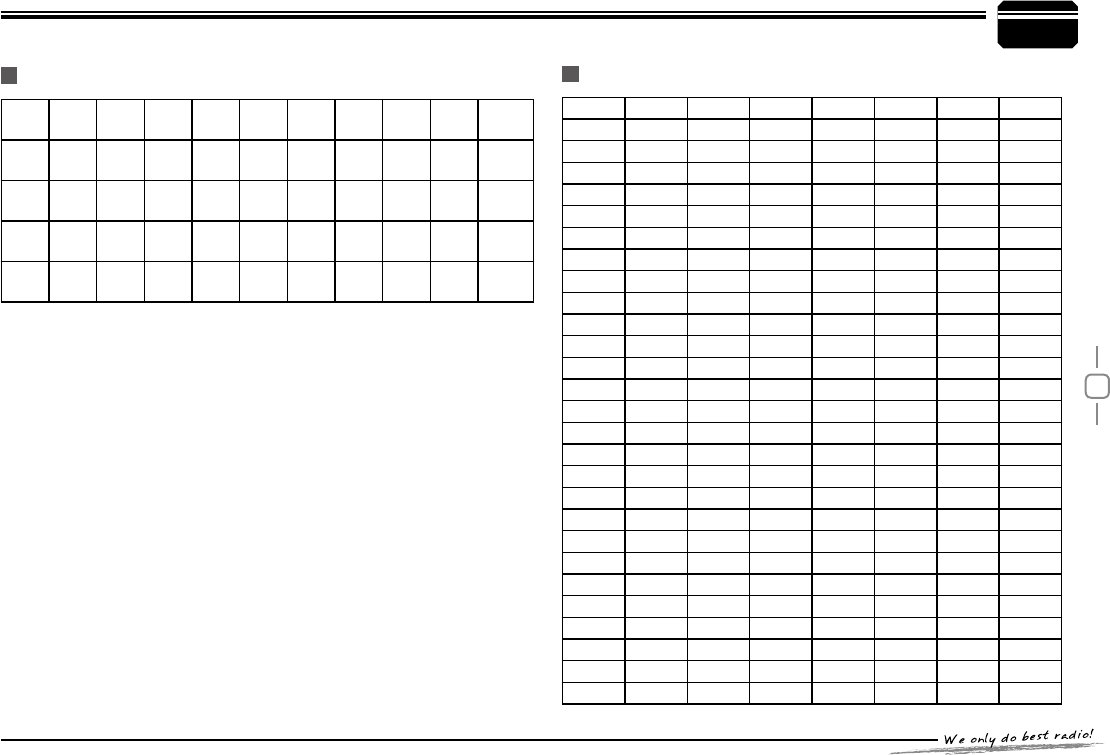
32
13
62.5 77.0 91.5 107.2 127.3 151.4 167.9 183.5 199.5 225.7 254.1
67.0 79.7 94.8 110.9 131.8 156.7 171.3 186.2 203.5 229.1 Self
Dene
69.3 82.5 97.4 114.8 136.5 159.8 173.8 189.9 206.5 233.6
71.9 85.4 100.0 118.8 141.3 162.2 177.3 192.8 210.7 241.8
74.4 88.5 103.5 123.0 146.2 165.5 179.9 196.6 218.1 250.3
51 GROUPS CTCSS TONE FREQUENCY(HZ) 1024 GROUPS DCS CODE
Attached Chart
000 001 002 003 004 005 006 007
010 011 012 013 014 015 016 017
020 021 022 023 024 025 026 027
030 031 032 033 034 035 036 037
040 041 042 043 044 045 046 047
050 051 052 053 054 055 056 057
060 061 062 063 064 065 066 067
070 071 072 073 074 075 076 077
100 101 102 103 104 105 106 107
110 111 112 113 114 115 116 117
120 121 122 123 124 125 126 127
130 131 132 133 134 135 136 137
140 141 142 143 144 145 146 147
150 151 152 153 154 155 156 157
160 161 162 163 164 165 166 167
170 171 172 173 174 175 176 177
200 201 202 203 204 205 206 207
210 211 212 213 214 215 216 217
220 221 222 223 224 225 226 227
230 231 232 233 234 235 236 237
240 241 242 243 244 245 246 247
250 251 252 253 254 255 256 257
260 261 262 263 264 265 266 267
270 271 272 273 274 275 276 277
300 301 302 303 304 305 306 307
310 311 312 313 314 315 316 317
320 321 322 323 324 325 326 327
330 331 332 333 334 335 336 337
14
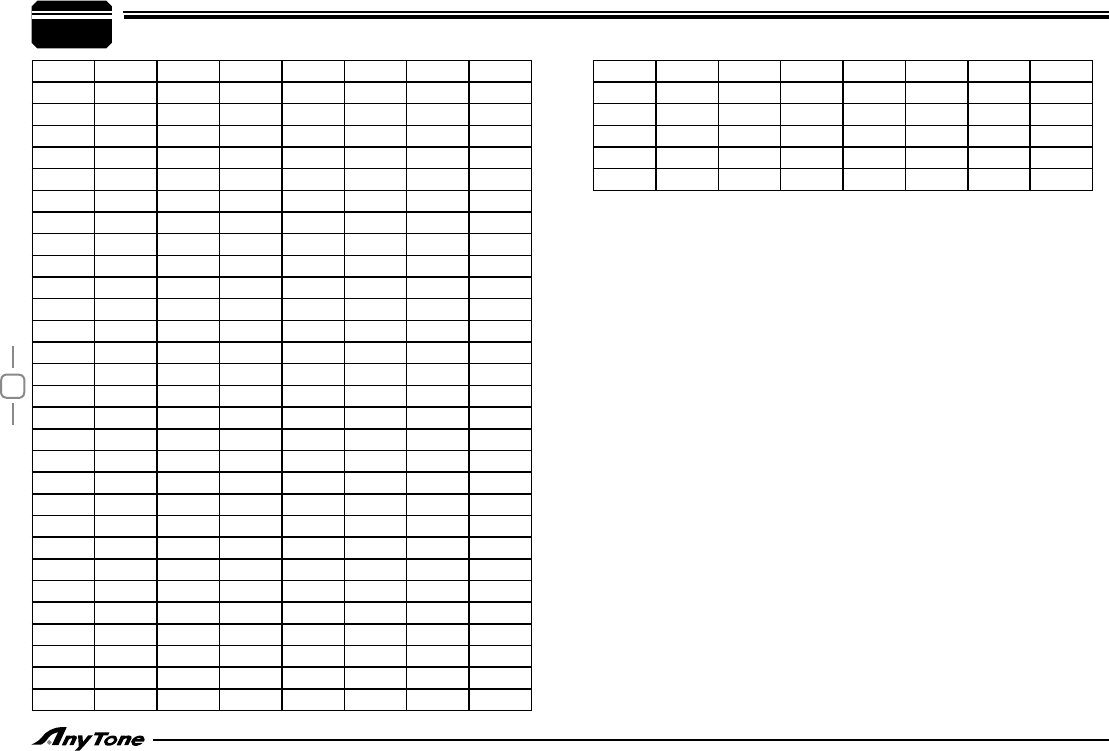
33
13
Attached Chart
340 341 342 343 344 345 346 347
350 351 352 353 354 355 356 357
360 361 362 363 364 365 366 367
370 371 372 373 374 375 376 377
400 401 402 403 404 405 406 407
410 411 412 413 414 415 416 417
420 421 422 423 424 425 426 427
430 431 432 433 434 435 436 437
440 441 442 443 444 445 446 447
450 451 452 453 454 455 456 457
460 461 462 463 464 465 466 467
470 471 472 473 474 475 476 477
500 501 502 503 504 505 506 507
510 511 512 513 514 515 516 517
520 521 522 523 524 525 526 527
530 531 532 533 534 535 536 537
540 541 542 543 544 545 546 547
550 551 552 553 554 555 556 557
560 561 562 563 564 565 566 567
570 571 572 573 574 575 576 577
600 601 602 603 604 605 606 607
610 611 612 613 614 615 616 617
620 621 622 623 624 625 626 627
630 631 632 633 634 635 636 637
640 641 642 643 644 645 646 347
650 651 652 653 654 655 656 657
660 661 662 663 664 665 666 667
670 671 672 673 674 675 676 677
700 701 702 703 704 705 706 707
710 711 712 713 714 715 716 717
720 721 722 723 724 725 726 727
730 731 732 733 734 735 736 737
740 741 742 743 744 745 746 747
750 751 752 753 754 755 756 757
760 761 762 763 764 765 766 767
770 771 772 773 774 775 776 777
14

A1.160426